#some often used variant interchangeably and that's it
Explore tagged Tumblr posts
Text
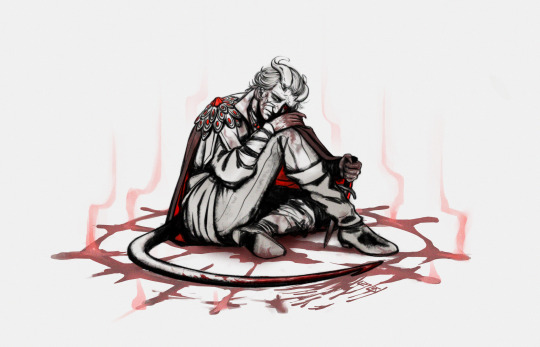
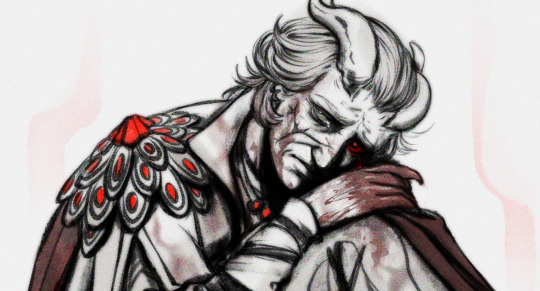
bloody inheritance
#bg3#baldur's gate 3#the dark urge#Ahieńčyk#tw blood#doodles#woag look at me finally back to posting something#i somehow got bg3 working for my old potato pc and ofc i chose durge as my 1st run#because why not and also the story is fucking delicious#even though i'm still only in act 1 </3#love having the most sad pathetic wet cat type of a character as my main in games#Ahienchyk uses she/her and is a necro wizard with affinity to use speak with dead on every corpse laying around#i'm honestly not sure abt the pronouns and consider she/it or she/he/it but we'll see ig#her name means “little flame” in belarusian#i honestly have no idea how to properly transliterate it to english with so many existing standards so i'll just use łacinka and#some often used variant interchangeably and that's it
42 notes
·
View notes
Text
I don't know if this has been talked about elsewhere but while writing Field of Reeds, I've found there's a very interesting amount of mythology and symbolism that ties in between Malenia, Miquella, and ancient Egyptian mythology. I think the concept of different soul parts (ba, ka, akh) is particularly insightful into a potential way to interpret how bodies and souls are referenced in Elden Ring.
One reason I think this may have served as at least some of the inspiration is the relationship between Elden Ring lore and real life mythology, specifically the Golden Order ties to Roman (and greek, irish, norse) mythology but also how those were influenced by ancient egyptian mythology. Miquella's character in particular seems to reflect on the past state of the world pre-Golden Order for inspiration on how to move forward in the future, similar to how the romans looked to ancient egypt in the past.
List of topics:
The Lotus | Trina & Miquella Lilies
Scorpions and Selket | Malenia, Goddess of Rot
Waterfowl, Nekhbet, and the Bennu Bird | Malenia, Blade of Miquella
Shed, Protective Child God | Miquella the Unalloyed
Death and the Soul | Godwyn, Trina, Dreams, and Spirits
The Acacia Tree | The Erdtree & Haligtree
Horus | Miquella the Kind
Hathor | Marika the Eternal
A few disclaimers: There is a vast amount of information on the mythology and there are a lot of contradictions and hotly debated topics within it and I'm no expert, so these will be mostly very surface level comparisons I think may have been used for inspiration, this is not intended to be a declarative comparison. I'll try to keep my sourcing consistent and most references will link back to a single source which compiled a lot of the references together. I did cross-reference these with other sources and will try to call out these additional sources as well as any contradicting opinions where applicable for additional perspective/context.
The Lotus | Trina & Miquella Lilies
Contrary to the name, the flowers referred to as "lotus" are actually two variations of water lilies, a blue and a white variant: Blue Egyptian Water Lily (Nymphaea caerulea) & White Egyptian Water Lily (Nymphaea lotus).


As you can imagine, this immediately caught my interest considering we have two variations of lilies in Elden Ring, Trina's lily (blue/purple) and Miquella's lily (unalloyed gold).
Unalloyed gold is representative of a pure gold and white is often the symbol of purity and that's no different here; additionally, at times white was even used interchangeably with yellow. Meanwhile for blue, you have the common themes of water and rebirth it's associated with but it was also commonly used in funerals. We know that water and this particular blue/purple hue in the game is associated with both dreams and death.
The lotus was also associated with alcoholic intoxication, and it was used as a recreational drug when soaked in wine; the roots and blossoms contain narcotic substances which are soluble in alcohol. It was also used in medicine (the juice has a mild sedative effect).
This last point is interesting in the context specifically of Trina's lilies and works well with my own interpretation of Trina's lilies being used as a sedative which I actually wrote even before stumbling across this fact.
The lotus was a symbol for life: at the very beginning of creation a lotus flower containing the god Ra was the first thing to emerge from the primordial waters. The lotus was strongly associated with the sun, as the flower retreats beneath the water at night and rises again each day at dawn like the sun-god.
As with many symbols of fertility, the lotus was also symbolic of rebirth after death. This again ties in well with the original concept of Miquella/Malenia being Abundance/Decay representing the cycle of death and rebirth.
The Egyptians looked forward to their souls coming to life "like a lotus reopening," and the Book of the Dead has a spell to allow the deceased to transform into one of these flowers. Faience models of lotus buds were sometimes placed in tombs. In many tomb scenes, the deceased is shown with a lotus flower held to his nose in order to breathe in the divine perfume.
Lotus Sources [x][x][x]
Scorpions and Selket | Malenia, Goddess of Rot
Like the lotus/lilies there were two common types of scorpions: a venomous land scorpion and a harmless water scorpion. As such, the scorpion had a dual purpose and could be seen as either friend or foe depending on the context much like how we see the scarlet rot both harms and strengthens Malenia. We also know the Rot God under the lake is at least in part scorpion in nature and thus this is best represented in Selket, the Scorpion Goddess, who is seen as benevolent and is often represented by the harmless water scorpion.

[Continued under the read more]
Scorpions were greatly feared and scorpion stings were one of the main hazards of everyday Egyptian life. Scorpions were described as “A very small thing, a sister of the snake, a sister of Apophis*, sitting at a crossroads, lying in wait for someone who goes in the night . . .”
I believe the scorpion sting serves as an apt representation of the way scarlet rot manifests and which I suspect is clearly intended with the blade crafted from the scorpion stinger of the Rot God sealed beneath the lake of rot.
[* I think there's an interesting parallel between Apophis and the God Devouring Serpent and Rykard but this is already too long, so here's a link about Apophis [x]]
Meaning of Selket: “She Who Causes to Breathe.” Selket's name refers to her power over scorpions, as those who have been stung tend to breathe too fast and too shallow because of the venom.
Another great description which ties in with the Scarlet Rot as it's shown in Elden Ring, specifically through the state of Millicent when we first come across her: slumped against a wall and breathing shallowly because in her words, "My flesh writhes with scarlet rot."
Selket was depicted with a scorpion above her head, as a scorpion, or as a scorpion with a woman's torso. She often had green skin, a reference to her help with regeneration in the Duat.
The last note here caught my attention knowing that Malenia's Great Rune which is covered in Scarlet Rot is what grants her the ability of regeneration. The specific callout of "in the Duat" is also of interest since the Duat is the underworld, meaning she regenerates in death (decay).
Historically, the scorpion was regarded as a symbol of motherhood in many areas, as female scorpions carry their young on their backs. The protective goddess Selket, who guarded the coffin of the deceased, was often pictured as a scorpion. An ancient Egyptian proverb states: “I love the scorpion, yet I know its venomous sting.”
This last passage I find summarizes Malenia's relationship with Rot and Decay fairly succinctly and ties in well with how I've always interpreted rot as the force of decay seeking to reestablish the proper life cycle into the Lands Between which had been forced into a state of stagnation from the removal of Destined Death. But because of the rejection of this rot and decay aspect, Malenia suffers the consequences, the venomous sting of the scorpion rather than the benevolence of it. This cascades down to her "children" as well where rather than accepting the rot and motherhood, she rejects both it and her "children" alike. This is actually very well contrasted by Romina in the DLC who finds strength when she embraces the rot and accepts the role of motherhood to those rejected by Malenia.
And, lastly, the visual of Selket guarding the coffin of the deceased is a striking visual comparison with Malenia in the roots of the Haligtree guarding Miquella's cocoon (his coffin) before it had been taken.
Scorpion and Selket Sources [x][x]
Waterfowl, Nekhbet, and the Bennu Bird | Malenia, Blade of Miquella
Another common concept seen in many religions is the association of birds as either representations of spirits passing or guiding them to the afterlife. While Malenia's title of Valkyrie is obviously a clear call to the norse mythology, there are once again roots of this concept that can be found in the Waterfowl, specifically the Heron and the phoenix variation of the Heron, the Bennu Bird. There's also the Vulture Goddess, Nekhbet, who serves as a protector of the dead/underworld.

A passage from the Book of Ani says that the first gate of the Duat was guarded by the Vulture Goddess, whose “tearing beak�� could admit the dead to the place whence they rose again. Amulets of vultures were buried with the dead, especially royalty. Egypt’s oldest oracle was the shrine of Nekhbet at Nekhen (modern Al-Kab), the original “necropolis” or city of the dead. [...] Nekhbet was described as “she whose wings are open, whose breasts are pendulous.” She was usually depicted as a vulture hovering with her wings spread, clutching an ankh or the Shen Ring in her talons. When pictured as a vulture, Nekhbet's colors are rarely true-to-life - instead she is symbolically red, blue, green, black, and white, the colors of life, the sky, regeneration, and holiness.
I've always found the reference of Malenia as a Valkyrie interesting because purely in the base game, she doesn't have any role actively acting as a guide of the dead. Rather, her role is as a protector, an undefeated champion and Miquella's blade - a role she obtains after studying with the mentor who led her to learn the "waterfowl dance" and gave her "wings of unparalleled strength". The main relation she has to death is to those she defeated in battle or inflicted with the Scarlet Rot, and her place in the roots of the Haligtree next to Miquella's cocoon.

The Bennu bird was the mythological phoenix of ancient Egypt. It was associated with the rising of the Nile, resurrection, and the sun. The sacred Bennu bird was thought to be a heron, and [...] were thought to lead the spirits of the dead through the dangers of the Duat.
The context is more interesting, in my opinion, when considering her as trying to be a guide through the underworld - specifically for Miquella. She knows her brother's plan to divest himself of his body and be resurrected (regardless of if you're considering base game lore or SotE lore) as she states clearly she "awaited his return". It's also clear that those who served Miquella knew he had also "died" in some capacity, killing themselves in flashes of light in the hopes to "guide his return". Personally, I think this was a missed opportunity to have her take on this role in Miquella's plot directly but that's neither here nor there.
The Hymn of the Bennu says: “I am a blue heron, pure as bone. I know the stirrings of the Nile, the source where water rises overlapped by trees, where ibises dip and wade, where the fish are plentiful. I fly beneath an arch of trees straight into the eye of heaven. I make a long journey amid mud houses, singing. I know the cool mind of the sky and the hot mysteries of earth. I am a blue heron, the messenger, a reborn and dying god. By day I exist because I exist. By night I sail above the river, a single star wise in the darkness.”
Likely incidental but another fun coincidence is that it is specifically a blue heron and Malenia has the association with the blue dancer charm and her mentor's blue robes. There's also obviously the water imagery, flowing water never rotting, but also water again being representative of death and rebirth, specifically associated with the phoenix in this case. We know for Malenia to reach her state as the Goddess of Rot, she has to die and bloom three times.
The Hymn of the Phoenix says: “I flew straight out of heaven, a mad bird full of secrets. I came into being as I came into being. I grew as I grew. I changed as I changed. My mind is fire, my soul is fire. I am the seed of every god, beautiful as evening, hard as light. I am the last four days of yesterday, four screams from the edges of the earth – beauty, terror, truth, madness – the phoenix on his pyre. I will live forever in the fire spun from my own wings. I destroy and create myself like the sun that rises burning from the East and dies burning in the West. To know the fire, I become the fire. I am power. I am light. I am forever. This is my deliverance. I am the fire that burns you, that burns in you. To live is to die a thousand deaths, but there is only one fire, one eternity.”
I don't really have anything profound here other than I love the visuals of this passage in relation to how they might reflect on Malenia's character. Malenia upon blooming in the scarlet aeonia is strikingly reminiscent of a phoenix being reborn from the flames, but there's also the interesting role fire plays in regards to rot, supposedly being able to burn it away to hold it at bay. In a sense by rejecting rot and embracing it only when the situation is desperate enough, she is continually welcoming her own repeated decay and rebirth. But perhaps this duality is intentional, if we consider the following passage:
Trapping waterfowl in a net is a common tomb scene since the Old Kingdom, although the representation of bird-trapping in a hexagonal net occurs already on an item found in a 1st Dynasty tomb. The scene is said to entail two aspects: one positive, related to the duck as a symbol of fertility linked to rebirth, and one negative, the birds as enemies of the dead, necessitating their being trapped to re-establish order in the cosmos. The birds, as a collective sign, refer to two contrary meanings by condensation.
I think where I ultimately fall in tying these three concepts together is Malenia's own fractured sense of purpose. I think her rot affliction and influence of the Rot God can be seen in some aspects of the Bennu Bird, her desire to be helpful and to achieve a better world can be represented by the Waterfowl/Heron, but the role she ultimately serves is as a protector of the dead (Miquella's cocoon) and represented in Nekhbet.
Heron, Nekhbet, and Bennu Bird Sources [x][x][x][x]
Shed, Protective Child God | Miquella the Unalloyed
Which deity better to compare to Miquella the Unalloyed than Shed, the child god, a deity who also has ties to the god Horus which I'll be discussing below in relation to Miquella the Kind.

Shed was pictured as a young man with a child’s Sidelock of Youth, wearing a kilt and an aegis, with a quiver of arrows across his back, riding in a chariot pulled by griffins.
We can largely see this exact imagery in the picture above and I found these interesting for a few notable reasons. The foremost is in his hunt of creatures, specifically snakes and scorpions as depicted above. We know from the earlier analysis there's the connection between Malenia's rot and the scorpion form of the Rot God - a nice parallel to Miquella fighting against her rot. There's also the bow and arrow, since it's strongly implied that Miquella invented both the pulley bow and crossbow, this also ties in well. But most curiously was the reference to griffins, given the only place in the entire game I can recall seeing griffin motifs is in the Haligtree. (Feel free to correct me if there's more elsewhere!)

Sure that may just be a Berserk reference, but that's so boring in comparison.
A protective god, Shed was pictured on many plaques and pendants. He was believed to guard against illnesses and wild beasts, and made sacred weapons of war.
Unlike the strong implication that Miquella made the pulley bow, we do know for a fact that he made the Hand of Malenia, which is inscribed with an incantation of Unalloyed Gold to make it resistant to rot, aka a sacred weapon of war.
Shed was often shown grasping serpents and other dangerous animals, and standing on the back of one or more crocodiles, to indicate that he had power over them. In some instances Shed was pictured as a mongoose.
Despite being a child god, Shed is clearly depicted as having power over the most dangerous creatures, not unlike how Miquella is referred to as the "most powerful" and "fearsome" Empyrean, and we can see this power through his charm ability and how he makes docile those who would otherwise prove to be a threat.
Over time, Shed was absorbed into the god Horus, as “Horus the Child.”
As we know, Miquella the Unalloyed eventually becomes Miquella the Kind which I'll get to soon, but first let's talk about the body, death, and souls.
Shed Sources [x]
Death and the Soul | Godwyn, Trina, Dreams, and Spirits
Rather than the concept of a single body and a single soul like much theology that came after, there's different facets of the soul that ultimately came to represent a person and each plays a different role in a person's life both while they are alive and after death. Understanding the nuance of each I think helps shed an interesting perspective on the Trina and Miquella situation in particular.
There are 5 main parts I will be focusing on: Khat (Khet), Ka, Ba, Akh, and Ab (Ib)
Khat (Khet) - The Body

Also called Khet, Khat was the physical body of the deceased, or mummy. On the day of a funeral, special prayers were recited over the mummy to aid in its transformation into a spiritual body, Akh, that could rise to heaven to dwell with the gods. The outer coffin often had a pair of eyes and a false door. This was so that deceased could "see" out, and their Ka (another part of the soul) could come and go.*
The physical body is the easiest, but we can also see in the description related to the coffin that the body still has a role to play in relation to the other parts of the soul, specifically the Ka. This is something to keep in mind when thinking about specifically Miquella's cocoon husk, Ranni's dead body, and Godwyn's soulless body.
[* Note: There is a heated debate in the community with regards to the specific role of the ka being able to return to the body and which resides in the Field of Reeds]
Ka - The Life Force

The hieroglyph for the Ka is two arms raised as if mirroring each other. The Ka is perhaps one of the most difficult concepts to describe, for there is no modern translation for this word. Essentially it appears to mean "double" as well as "vital force" and is a clear reference to a part of the individual that transcends the death of the physical body. Egyptologist Richard Wilkinson explains that "in all periods it is used as a term for the creative and sustaining power of life."
This concept of the Ka representing the part of the soul linked to the body I believe ties in well with the concept of multiple deaths that characters in Elden Ring can experience. Now we know when any of the Remembrance bosses die, they're hewn into the Erdtree, taking their shape.
The Ka was something handed down from one's parents, grandparents, and ancestors, like spiritual DNA, traceable in the very remote past to a creator god by way of lesser deities. The Ka was not only one's double but also a guide and protector, imbued with the spark of the divine. According to pictures drawn during the 18th Dynasty, the Ka came into being when a person was born, often depicted as a twin or double, but, unlike the body it belonged to, it was immortal provided it received nourishment.
We see here that it is also believed that under certain circumstances a Ka can be potentially immortal.
The gods themselves were felt to possess a Ka. Egyptologist Dimitri Meeks explains that the vital force that the ancients ascribed to the Ka acts in such a way as to give each deity the ability to take creative form infinitely. Because of this ability, it was this essence, the energy of the deity's Ka, which was felt to temporally inhabit statues and other magical images during ritual, or sacred animals.
In essence, a Ka can vary in shape (when associated with a deity) and is closely bound to the body. It is also able to be imbued in statues or other images - think puppets, or dolls in Ranni's case. Essentially as long as there is something in the realm of the living for Ka to inherit, it can continue to exist in some regard.
The Ka of the pharaoh was thought to be the collective life force of all his subjects - crucial to their well-being, indeed to their very existence. The term "By the Ka of the pharaoh" meant "by the good grace of the pharaoh."
This gives and interesting twist to the concept of the Erdtree which we know is used to facilitate life and rebirth in the Lands Between by returning the bodies of those who perished to it, as well as giving a unique perspective on the concept of grace since only those granted grace by Marika technically "belong" in the Lands Between.
Dying was referred to as "going to one's Ka." Upon the body's demise the Ka rejoined its divine origin, but always remained in close proximity of the body.
One way to potentially conceptualize the Ka is any manifestation of the soul or spirit of the deceased that remains in the land of living rather than the underworld: Spirit Ashes, Puppets, Ranni's Doll(s), Sellen's Primal Glintstone, etc. In Godwyn's case, this implies that his body (Khat) may live, this part of his soul (Ka) was killed and Ranni's was the inverse which is how she's able to continue living.
Ba - The Ego

The personality or alter ego of the deceased. The Ba was said to be able to fly from place to place during the day and is often shown hovering over the mummy or resting on a shrine. Migratory birds were regarded as nations of the Ba, flying freely between tomb and underworld. Supposedly the Ba could assume any form it chose, and the Book of the Dead has many spells to assist the Ba in its transformation. Some of the most common transformations of the Ba were into rams, a lotus, and other birds such as swallows.
Now of course, I read this and immediately thought of Trina, and while I don't think the concept of the Ba in how it functions here is a one to one for the manifestation of Trina, I believe it provides a very unique framework for how to conceptualize her existence. SotE made it abundantly clear that there is a very clear overlap between sleep/dreams and death and if we take the freedom of movement the Ba has literally this makes sense. In the context of Miquella and Trina, this makes Trina an aspect of Miquella that is able to traverse the underworld, able to walk death.
Though the Ba seems to have been essentially nonphysical, it nevertheless could be viewed as a separate physical mode of existence for its owner, even prior to death. Hence, the sun was the Ba of Ra, the wind was the Ba of Shu, water was the Ba of Nun, and crocodiles were the Bas of Sobek. Deities often had multiple Bas - Ra was thought to have seven Bas, and it was claimed that Amun had ten Bas.
It's the line "even prior to death" that caught my attention and I think this mostly applies to Miquella and Trina but could also be applied to Marika and Radagon - though I believe the alchemy concept suits them better. If a Ba is a form of the soul that can exist prior to death and manifest in some way, traversing to the underworld, well that sure does sound like Trina doesn't it?
Every evening the Ba returned to the body, reuniting with it and thus ensuring the body's continued existence in Sehet Aaru (the Field of Reeds). The body had to be recognizable to the Ba, hence the careful mummification and elaborate mummy masks.
Revisiting the concept of Godwyn again, we know without his soul and with the Rune of Death corrupting his body, it begins to mutate and transform. It provides an interesting explanation for why the eclipse ritual may not have worked even if the eclipse did come to pass: his body in its mutated state, spread far and wide across the lands between is no longer recognizable. He cannot come back to life because of how his body was desecrated. It also provides an explanation for why Ranni was able to continue living: we find her body, still reflecting her form, at the top of her Divine Tower.
The ram was the animal symbolic of the Ba, a major aspect of the Egyptian notion of the soul; the Egyptian word for “ram” was “ba.”
Now this is purely a parallel I purely enjoyed thinking about when considering the Ancestor Spirits and specifically the concept of Torrent being a juvenile Ancestor Spirit.
Calling Back the Ba of Osiris says: “My Ba is a restless bird that leaves to seek itself. For the falcon who breaks the confines of the shell, even the sky it not enough eternity. He may be tossed by storms of whirling sand or ride a hot wind above dunes. Far from here his voice may ring though the forests from the branches of a fruit tree. By the Nile he may wait silent among the reeds, fish spawning as he sleeps, his head tucked in his wing. Burn saffron; remember my prayers. The smoke of incense will bring him home. Though far and sailing, my Ba comes back to me. In his copper beak he carries my thoughts. On his back my starry dreams fly over mountains, over seas, over villages. Above the grape arbor it is I sailing with the falcon, triumphant. Perhaps now he hovers near, flurry of dark wings beating the door; or he follows the rivers and canals of gods, leading them through mountains; or he binds the souls to the rags of mummies, filling dry hands with perfume. Old ones grasp their scepters and rise barefoot in the burning sand. Perhaps he twitters above boats with their cargoes of amethyst, sailing home. Ah, my Ba's a restless bird. On dark wings he flies from yesterday, love in his throat, the warmth of light among his feathers, the risen sun in his hard, amber eye. If you see him, send him home to me. The heart is uncertain country."
Nothing profound here, again, I just really love the way this passage presents the concept of the Ba.
Akh - The Enlightened Spirit
The Akh was the immortal, transformed self, which was a magical union of the Ba and Ka. Strudwick writes, "once the Akh had been created by this union, it survived as an 'enlightened spirit,' enduring and unchanged for eternity." [...] The Akh could return to earth, however, and it was an aspect of the Akh which would come back as a ghost to haunt the living if some wrong had been done, or would return in dreams to help someone they cared for. Letters and offerings were left at the deceased's tomb in hopes that the Akh would watch over those still on earth.
No image for this one, but I believe the Akh represents the process of ascension well, though in Miquella's case it would imply he has achieved a bastardized form of ascension given that rather than joining his Ka and Ba, he discarded (at least one) of his Ba: Trina. Perhaps some form of it was achieved through the chopping and mashing up of the souls of his family, especially if we think back to the concept of a Pharaoh's Ka encompassing all it's subjects - in this case, all of Marika's childen could be considered part of her Ka.
The Egyptians thought the Akh was a radiant light, something like a star. The Pyramid Texts tell us that when a man dies, his Akh goes to the stars to dwell with the gods - "the Akh belongs to heaven, the corpse to earth."
I love the idea of a version of godhood or ascension being represented by the stars given we know in Elden Ring, the stars are also represent primordial life just like the Crucible.
Ab (Ib) - The Heart

The most important part of the Egyptian soul was thought to be the Ab, or heart. The Ab was believed to be a drop from the heart of the mother of the child at conception. The heart was thought to be the source of good and evil within a person, the moral awareness and center of thought that could leave the body at will. [...] To the ancient Egyptians, it was the heart and not the brain that was the seat of emotion and thought, and was the key to the afterlife. To lose one's heart was a terrible fate, and to prevent such a calamity no less than seven chapters of the Book of the Dead were dedicated to help prevent this from happening.
This summarizes the tragedy of Miquella's ascension through discarding his love in the form of Trina better than I could. I'll leave you with one final passage I adore when thinking about the tragedy of the heart:
A spell called Giving the Heart to Osiris says: “My heart sleeps. My heart dreams. Give me a mouth. I want to talk. Give me my legs and I'll rise. Give me my hands and arms and I'll fight. I'll crush the skull of the snake. Open my blind eyes, straighten my bent feet. I know my heart. It stirs within me. It throbs in my right hand. Blood quickens beneath my skin. Give me my heart. Let it pump again life's power in me, infuse my hands and feet with spirit. Give me my heart. Let me rise and walk. I am quickened. No more sleep. No more dreams. No more death."
Death and Soul Sources [x][x][x]
The Acacia Tree | The Erdtree & Haligtree
Another botanical reference that is common to a lot of religions is the concept of a Tree of Life, in ancient Egypt this is referenced by the Acacia Tree.

Sometimes called the "Tree of Life" in Egyptian mythology, the first gods were said to have been born under the sacred acacia tree of the goddess Hathor, and Horus was also said to have emerged from it.
I think there's some very interesting parallels as well between Hathor and Marika as well as Horus and ascended!Miquella which I'll get into below.
According to myths, the acacia protected the body of Osiris, and the acacia was known as Nht Hnmt Ntr ("The Tree That Encloses the God.")
Again, another interesting parallel to the function of both the Erdtree and Haligtree in how they are presented in Elden Ring. The Erdtree houses the form of Marika/Radagon while the Haligtree - designed to be a replacement to the Erdtree - which housed Miquella's cocoon at one point and is actively where Malenia is when she ascends to her "Goddess of Rot" form.
Acacia Sources [x][x]
Horus | Miquella the Kind
While not a perfect parallel, I think in relation to Shed who later becomes the precursor to Horus as "Horus the Child", looking at the deity Horus in relation to specifically ascended Miquella can provide a unique perspective.

Egyptian texts paint a dazzling picture of Horus: "when he opens his eyes he fills the universe with light, but when he shuts them darkness comes into being." When the Osiris myth became popular, Horus became the patron of young men and was often described as the perfect example of the dutiful son who grows up to become a just man. Weak as a child, Horus was nurtured by his mother Isis and grew into manhood. Mythologically, the sun and the moon represented the two eyes of Horus.
Perhaps not the most insightful, but interesting with the knowledge that Miquella's eyes hold eclipses in them, representative of his goal to bring the state of Godwyn to one where he could provide him a true death.
Early hospitals at Alexandria were under the protection of Horus - Horus was thought to have become a doctor on account of the many illnesses he suffered as a child. Consequently, the Eye of Horus amulet was thought to have healing powers, and to ward off the evil eye and protect against all sorts of illnesses.
We know that Miquella cast so much aside in his effort to heal Malenia, and I still firmly believe was one of his primary goals and reasons for seeking ascension. So while not his own illnesses he suffered as a child, it would thematically still fit.
Lastly, here's two other interesting passages:
The Speech of Horus says: “I am Horus, the Great Falcon. My flight has reached the horizon. I have passed by the gods of Nut. I have gone further than the gods of old. Even the most ancient bird could not equal my very first flight. There is no god who has achieved what I have achieved. I am Horus, whom Isis bore and whose protection was made inside the egg. I am Horus, Son of Osiris.”
The Hymn of Horus says: "I come to the room where the sun rose. A falcon flies in and settles on my wrist. In his mouth hangs the skin of a snake. ‘I am Horus,’ he cries. ‘From the land of kings I come, riding through the hot winds on the back of a jackal. Where priests murmured in crumbling temples, I flew through their sacred fires dropping feathers. I come to shout the wisdom of air. I’ve come with a sycamore seed in my beak. By the river we’ll sow it and watch it grow through the years. You will die there, Osiris; and I will sit nine thousand years in the tree’s white branches, one eye on each horizon, waiting for your return. I am life rushing on, born from the egg of the world, born from the belly of a magic woman, born of my father’s dreams. I am the screech of wind, the rush of falcon wings, talons sharp as knives. I came after you. I stand before you. I am with you always. I am the power that dispels darkness. The seed laid into the void must grow. The candle’s only purpose is to shine in the darkness. Bread is meant to be ground to pulp in the teeth. The function of life is to have something to offer death. A man forgets, but his heart remembers – the love and the terror, the weeping, the beating of wings.'”
Horus Sources [x]
Hathor | Marika the Eternal
While I think Isis can be an interesting deity to consider for pre-God Marika, I find Hathor slightly more fitting for her ascended godhood.
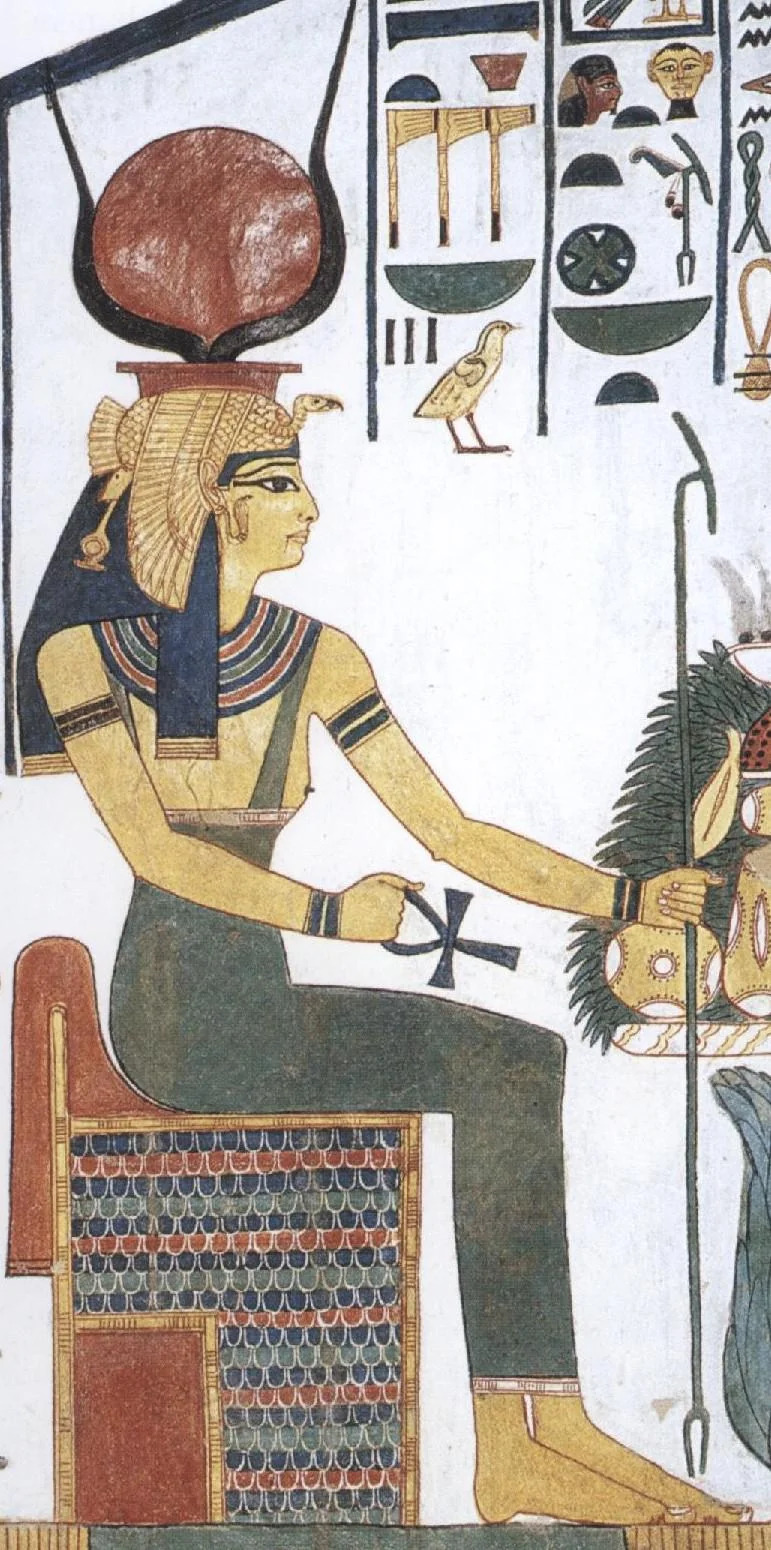
Hathor is understood to be the deity who welcomes the worthy dead, offers them refreshments of food and drink, and leads the way into the blessed beyond. One of the desires of the deceased was to be in the following of Hathor - "I tread the stars and climb the sunbeams in the retinue of Hathor, I rise to the sky."
Despite the Land of Shadows canonically existing, I believe that's just another realm where death manifests while the Lands Between represents another, and in a sense could be considered something like "the blessed beyond" for those granted her grace. It also explains how those like the Tarnished could be cast out and only permitted back once she returned the vision of grace to them.
Hathor's attributes as a mother goddess were exalted - it was she who gave birth to gods, shaped animals and people, and brought greenery into existence. Hathor repelled the shadows and illuminated all creatures with her light. The inundation of the Nile happened on her command, and the winds drew near on her orders.
Quite a literal parallel to both her removal of Destined Death and sealing away of the Land of Shadow, also bringing light to the land in the form of the golden shine of the Erdtree.
In one Egyptian tale, Hathor was charged by Ra to punish humankind. So great was the slaughter that Ra feared people would be wiped out, and ordered the goddess to halt. But blood-mad, she ignored him. These two aspects of Hathor - violent and dangerous versus beautiful and joyful - reflected the Egyptian belief that women, as the Egyptologist Carolyn Graves-Brown puts it, "encompassed both extreme passions of fury and love."
I hadn't expected to find something like this when first reading about Hathor but obviously this is reminiscent to how Marika lead her genocidal wars.
Hathor Sources [x]
Conclusion
This is all I plan to cover but there's a lot more I could have such as Apophis; gold, silver, and ivory; hair, braids, knots, and power; and so much more. But this is already super long so I encourage anyone interested to take a stab at looking into it yourself if you're curious. If you made it to the end, thanks for reading and let me know your thoughts!
#Elden Ring Lore#cinder rambles#long post tw#malenia blade of miquella#miquella the unalloyed#whatever i spent too much time on this i might as well put it in the tags#its also SO long like buckle up if you're going to read this#obviously not perfect parallels but there's enough that it made me go “HMM” and deep dive so here you go#if nothing else it's interesting food for thought
28 notes
·
View notes
Note
Im curious if FMC is a fae. Would she have wings like other fae depictions ???
Traditionally, faeries are depicted with a wide variety of features.
Appearances greatly vary depending on the region the beliefs have come from.
Keep in mind Irish, Scandinavian, Nordic and Celtic folklore may have common roots but they are all very different.
And in some instances the word 'Fae' can be used interchangeably with the word 'Elf' and/or as an umbrella term used to refer to a group of species belonging to the same family (the same way tigers, lions, and house cats are all objectively different but are also all felines).
-> For example, there are The Huldufólk or The Hidden People who are a race of elves that originate from Icelandic/Faroese Folklore. They behave much like humans and bear a strong resemblance to us, but they are also noteworthy for their natural ability to make themselves invisible at will.
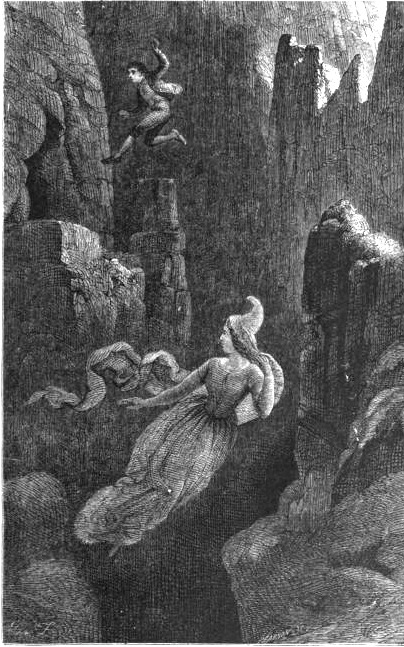
(Engraving of a man jumping after a female elf into a precipice.)
-> In traditional Norse Mythology, you have the Álfar. The Ljósálfar ("Light Elves") and the Dökkálfar ("Dark Elves") who are two contrasting types of elves; the dark elves dwell within the earth and have a dark complexion, while the light elves live in Álfheimr (Alfheim), and are "fairer than the sun to look at". They are both attested in the Prose Edda, written in the 13th century by Snorri Sturluson, and in the late Old Norse poem Hrafnagaldr Óðins.

(“Oberon, Titania and Puck with Fairies Dancing” illustration by William Blake, c. 1786)

(“Älvalek” or “Elf Play” although the museum lists it as “Dancing Fairies” - oil painting by August Malmström 1866)
-> In Irish folklore, The Tuatha Dé Danann (meaning "the folk of the goddess Danu") are also known by their earlier name Tuath Dé ("tribe of the gods"), because in some beliefs the Fae are depicted as Demoted Pagan Deities. They are described as a supernatural race, much like idealized humans, who are immune from ageing and sickness, and can wield magic. The powers most often attributed to the Tuath Dé are control over the weather and the elements, and the ability to shapeshift.

(The Tuatha Dé Danann as depicted in John Duncan's Riders of the Sidhe - 1911)
All in all, in folklore, faeries actually rarely have wings, but they are often depicted with them in Victorian and later artworks.

(A portrait of a fairy, by Sophie Gengembre Anderson - 1869. The title of the painting is Take the Fair Face of Woman, and Gently Suspending, With Butterflies, Flowers, and Jewels Attending, Thus Your Fairy is Made of Most Beautiful Things – from a verse by Charles Ede.)
What I've noticed is that, in the traditional sense, fairies often fly using magic, or by perching on the backs of birds, ragwort stems, or other mythological creatures like dragons or gryphons.
And some depictions are vague enough to attest a certain attribute (like wings) as a creative liberty to a faerie that, say 'lives in the sky'.
But does that mean the Fae in early folklore do not have wings at all?
Absolutely not.
Thus far, I've only listed depictions of the Fae that are most reminiscent of the 'traditional Elf'. But have you ever heard of Leprechauns... Banshees... Changelings...Pixies... Mermaids...
Sprites, Goblins, Gnomes?
The freaking Headless Horseman?
Because they're all also Fae.
There are also faerie animals. Heard of Kelpies, anyone?
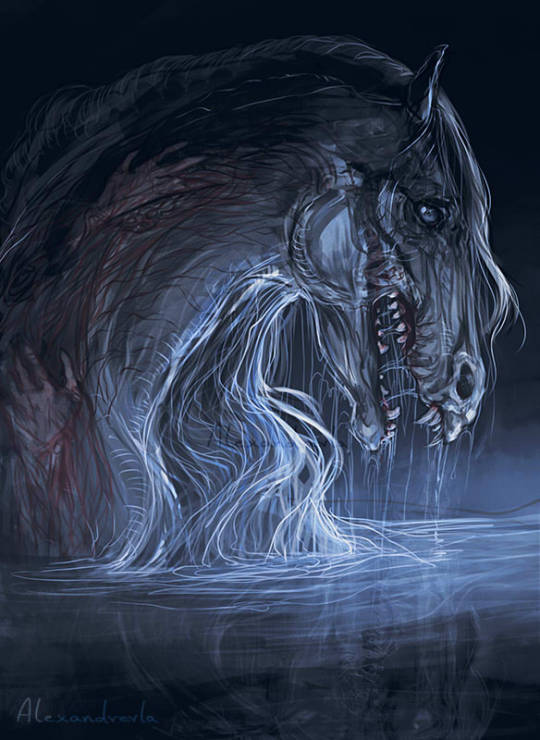
And quite frankly, it is not possible for me to summarize the scope, the depth and the richness of the cultures depicting these creatures with all of their variants. There are Eastern cultures, Western cultures, Indigenous cultures; I'm Bulgarian and my own culture has beliefs about faeries and Fae-like beings (the Slavs are a whole different ball game when it comes to that).
People dedicate their entire lives to become Folklorists and will still barely scratch the surface. All in all, there's just not one set of rules for the Fae, we can't amalgamize them into one thing, that's just not how it rolls.
So what can I say about my depiction of the Fae in Path of Alfheim?
Well... I have a ton of variety to play with. 😁
My understanding is that the Fae all vary from each other depending on their lineage, their upbringing, their alignment, the territories and/or 'realms' that they inhabit. There are so many species out there that every shape and form you can possibly think of likely exists.
And besides the faeries that live on land, there are also lake folk, sea folk, mountain folk, valley folk, air folk, a specific corner of the room at night folk.
They can be spirits, ghosts, animals, monsters, elementals, demons, demoted angels, deities, humanoid... It goes on.
Something that hugely inspired me, and what I think is a beautiful depiction of the Fae, happens to be the Disney Maleficent duology with Angelina Jolie as the main female lead. The production had Holly Black, a New York Times best-selling author of over thirty fantasy novels (The Cruel Prince being one of them) and a Faerie Folklorist, on set.
And, oh, would you look at that?

Maleficent has wings. 😉
So whether the FMC does as well is up to the interpretation.... for now.
Thank you for the Ask, Anon! ❤️
18 notes
·
View notes
Text

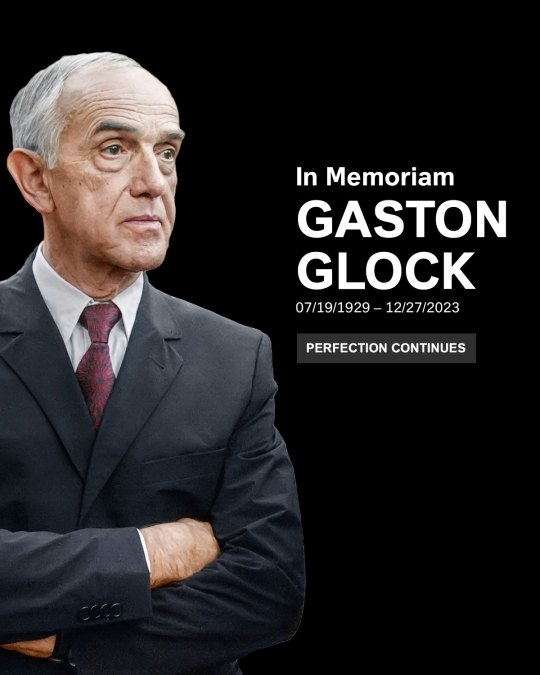
Glock Pistols Series (Tribute to Gaston Glock)
GET YOURS HERE!!!
Just remastered some old works of the Glock Pistol Series as a tribute to the late Gaston Glock, the inventor of the Glock Pistol that has significantly contributed to the firearms industry since 1982. Rest in peace, sir. Your legacy will remain in our hearts, and your contribution to the firearms industry, especially pistols in Late 20th Century. Sorry For Late Tribute Post. I Need to Find the Best Glock Model for this Tribute and Improving the Existing Models Thank you @exzentra-reblog @coffee-cc-finds @bdangkingfish @evgenyesipov1999 @sparkiekong @helenofsimblr @igglemouse
Known for its distinct shape like a box, Glock emphasizes its tradition of perfection in almost every design they issue. The journey began in 1982 when Glock Ges.mbH introduced their 17th patent, which would later be known as the Glock 17. It is a 9mm-chambered pistol that would change the mindset of the sidearm industry. Although not the first polymer-made pistol (the first was an HK VP70), it offered the value of a lightweight, high-capacity magazine pistol. The Glock 17 entered the US market in 1986. Despite initial rejection by both Glock and the US Military as a replacement for the 1911, Glock started to capture the attention of American police departments (PDs).
By 1987, it began to be adopted by police departments, with others following suit in issuing Glocks as their standard sidearm. The key to Glock's success in police departments lies in its affordable price, ease of maintenance, numerous interchangeable parts, and, of course, the double-trigger system. Although it may be challenging to execute a follow-up shot quickly, it ensures safety when the pistol is not in use. Additionally, this sidearm is popular for deployment alongside the Secret Service.
In this case, VVE covers some of the Glock series to the SimVerse usage, like :
Standard
Standards Glocks are full-sized pistols that are designed for duty and home defense use. Barrel lengths are 4.49 inches and 4.61 inches depending on caliber. Standard-sized Glocks are some of the most commonly sold pistols and strike the right balance between size, weight, and controllability.
Glock 17
The Glock 17 is the original 9×19mm Parabellum model, with a standard magazine capacity of 17 rounds, introduced in 1982. Glock also offers a version of the standard magazine which incorporates a longer "+2" base plate to provide a capacity of 19 rounds. Also, a 10-round version of the standard magazine was created for markets that restrict the magazine capacity of handguns. And, Glock offers an extended 24 round (with flush base plate) magazine for the Glock 17. Finally, the Glock 17 can use the Glock 18's extended 33 round (with +2 base plate) magazine. The base plates for the extended magazines can be swapped out to create 26 and 31 round magazines as well

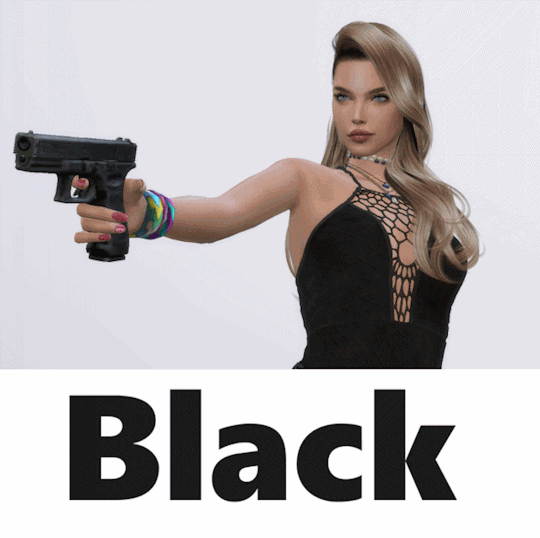
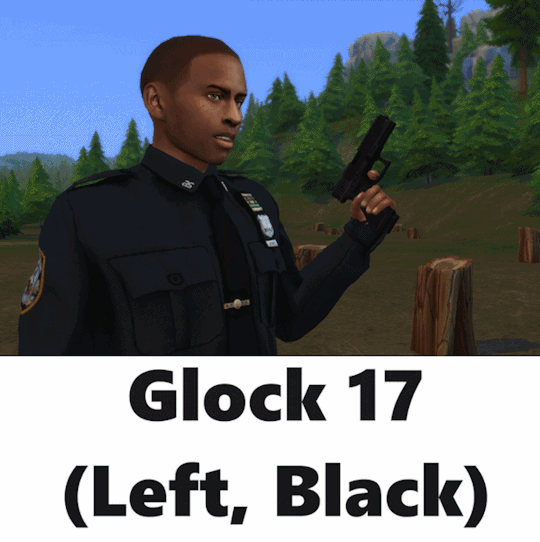
Thank you For @effiethejay For NYPD Uniform!
Glock 22
Also a standard-barrel version, but in this case, with a silver sliding) in Reality this is Just A Glock 17 Chambered with 40 Smith & Wesson for Better Punch. Perfect Pistol For FBI And Law Enforcement who looking better Punch but Maintain Controllability.

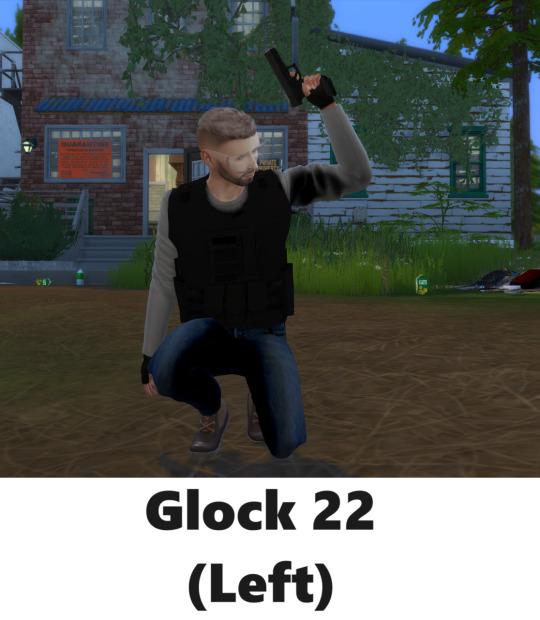
GLOCK 18
The Glock 18 is a Select Version variant of the Glock 17, designed for the Austrian counter-terrorist unit EKO Cobra. Introduced in 1986, it features a selective-fire option, allowing both fully automatic (1,100–1,200 RPM) and semi-automatic firing modes. The circular selector switch on the rear left side of the slide controls the firing mode. The pistol is often equipped with a 33-round magazine and can be used with or without a shoulder stock for added stability. This Particular Model is First Production of Glock 18 which marked by Extended Barrel and Lack of Compensator to Reduce the Recoil.
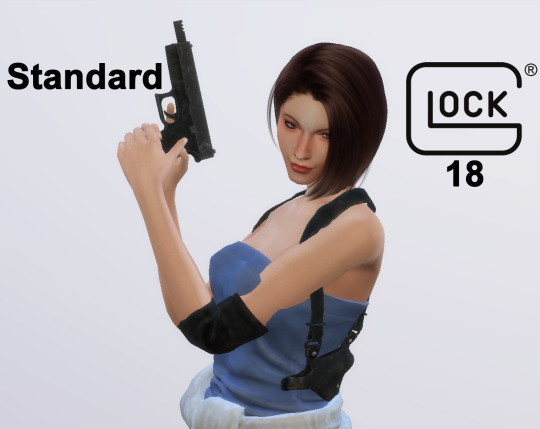

Thank you For @plazasims For Jill Valentine outfit & @mimoto-sims For Pose
GLOCK 18C
The Improved Model Of Glock 18. The compensator cuts start about halfway back on the top of the barrel. The two rear cuts are narrower than the two front cuts. The slide is hollowed, or dished-out, in a rectangular pattern between the rear of the ejection port and the rear sight. The rate of fire in fully automatic mode is around 1,100–1,200 rounds per minute. Most of the other characteristics are equivalent to the Glock 17, although the slide, frame, and certain fire-control parts of the Glock 18 are not interchangeable with other Glock models.


Thank you For @pandorassims4cc For Pose
Compact
Compact is a relative term. These Glocks are still somewhat large with barrel lengths of 4.02 inches and grips that fill your hand. The slightly shorter grip and barrel length allow them to be easier to conceal and more comfortable to carry while maintaining control over the gun. That being said, this is the most popular category of the Glock sizes.
GLOCK 19
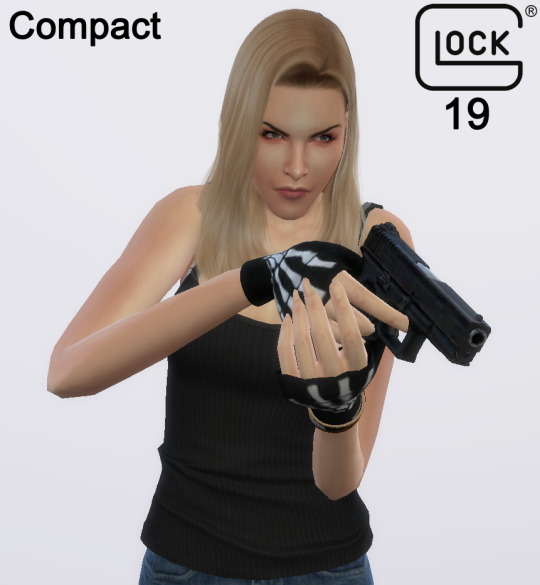

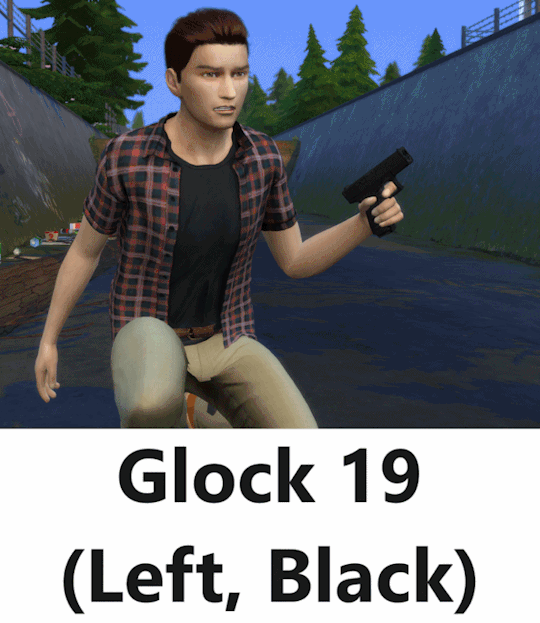
The Glock 19 is effectively a reduced-size Glock 17, called the "Compact" by the manufacturer. It was first produced in 1988, primarily for military and law enforcement. The Glock 19's barrel and pistol grip are shorter by about 12 mm (0.5 in) than the Glock 17, and it uses a magazine with a standard capacity of 15 rounds. A 10 round version of this magazine is also made for markets that restrict the magazine capacity of handguns. And, a "+2" base plate can make the standard magazine into a longer 17 round magazine. The pistol is also compatible with any magazines designed for the Glock 17 and Glock 18, providing factory magazine capacities of 17, 19, 24 and 33. Changing out base plates adds capacities of 26 or 31 rounds.
Subcompact
Subcompact Glocks are designed to be concealed carry weapons and backup guns. These guns sport ultra-short frames, and barrel lengths vary between 3.43 inches and 3.78 inches depending on caliber. These guns are straightforward to carry and conceal in almost any way you want.

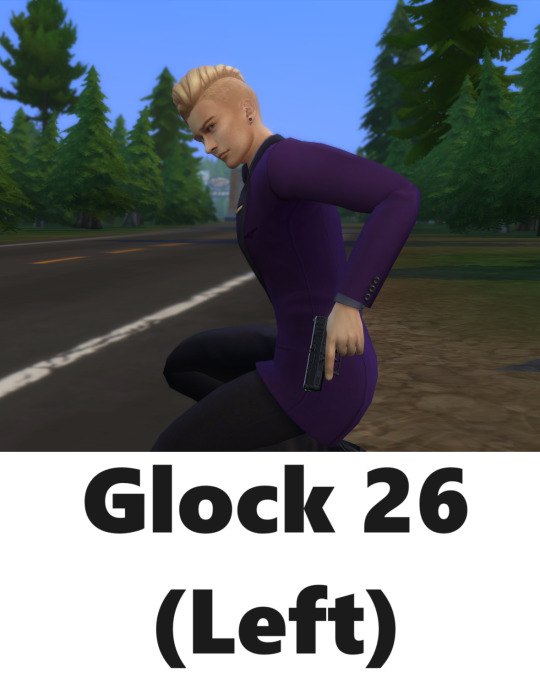
The Glock 26, a 9×19mm "subcompact" variant designed for concealed carry, was introduced in 1995, primarily for the civilian market. It has also been acquired by the US military and designated MK 26. Featuring a smaller frame compared to the Glock 19, the pistol grip supports only two fingers, and it has a shorter barrel and slide, along with a double-stack magazine with a standard capacity of 10 rounds. A factory magazine with a +2 extension gives it a capacity of 12 rounds. Additionally, the Glock 26 can use factory magazines from the Glock 17, Glock 18, and Glock 19. One can swap out base plates to give it capacities of 15, 17, 19, 24, 26, 31, and 33 rounds. More than simply a "shortened" Glock 19, the design of the subcompact Glock 26 required extensive rework of the frame, locking block, and spring assembly, which features a dual recoil spring.
Competition & Long Slide
By bigger than full-size, we are talking about guns mostly made for competition shooting. They have standard sized frames but longer slides and barrels. The longer slide and barrel gives a longer sight radius and a higher velocity, as well as less recoil and muzzle flip.
GLOCK 34
The Glock 34 is a competition version of the Glock 17. It is similar to its predecessor, the Glock 17L, but with a slightly shorter slide and barrel, to meet the maximum size requirements for many sanctioned action pistol sporting events. It was developed and produced in 1998, and compared to the Glock 17, features a 21 mm (0.8 in) longer barrel and slide. It has an extended magazine release, extended slide stop lever, 20 N trigger pull, and an adjustable rear sight. The sides at the front of the slide are slanted instead of squared. Further, the top of the slide and parts of its inside are milled out, creating a conspicuous hole at the top designed to reduce front-end muzzle weight to better balance the pistol and reduce the overall weight of the slide. The Glock 34 can accept any magazine the Glock 17 can accept.

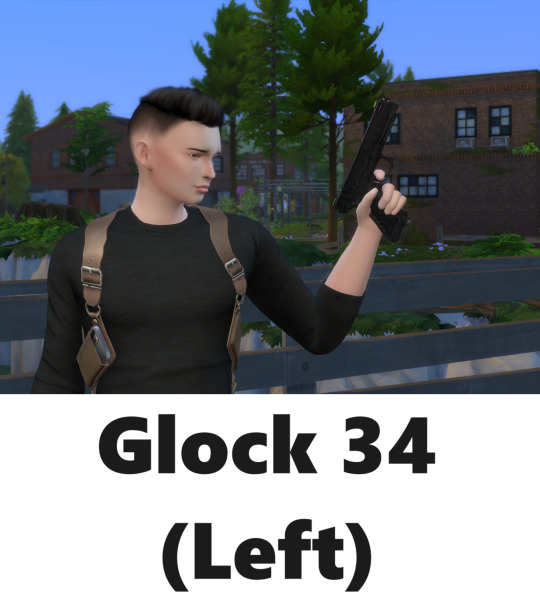
#the sims 4#the sims#the sims 4 custom content#ts4#ts4 cc#the sims 4 military#ts4military#the sim#the sims 4 cc#ts4cc#ts4 gun#the sims 4 gun#ts4 military#gaston glock#glock#glock 19#glock 17#firearms#austria#ts4 download#ts4 cas#sims 4#ts4 simblr
35 notes
·
View notes
Photo
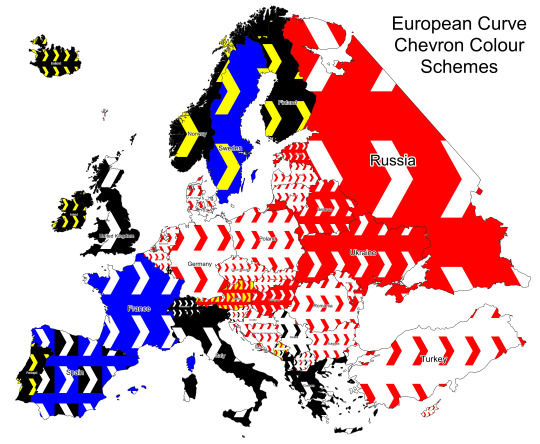
Map of European Road Curve Chevron Signs
by u/isaacSW
Not sure if something like this has been done before but I’ve put together a map showing the colour schemes used on the chevron signs used on road curves throughout Europe (this is the sort of thing I’m talking about). I think it could be quite powerful in some areas, like the Balkans and central Europe, where they are quite common and the colours vary a lot from country to country.
This won’t be 100% accurate, and I’m sure you will be able to find counterexamples, but I have checked multiple signs in each country and it appears to be a fairly reliable clue. If you do find anything I’ve missed, let me know and I will update the map and post the link below. Here is a list of observations I’ve made while making this map, with example locations.
Notes:
The white colour is often substituted for luminous green/yellow in high altitude/latitude areas (example). Austria and Montenegro have their yellow variants shown on the map as they appear to greatly outnumber the corresponding white variants. The yellow colour on south-facing signs will often fade to near-white.
Some countries will add a luminous yellow outline to the signs rather than replacing the white (generally in high altitude/latitude areas). Some countries that do this are: Italy, Romania, Hungary, Russia, the UK, Belgium and Turkey.
Most countries will also have a long variant of the curve chevron sign (example). This should be the same colour scheme as the single-chevron signs, however it may be less obvious which is the ‘background’ and which is the ‘chevron’ colour.
Notable Countries:
Spain uses both the white-on-blue and white-on-black interchangeably. It is always the long variant (as far as I can tell), and the colour distribution does not seem to vary by geographic location. (blue example, black example)
Montenegro uses the red-on-yellow (example) and black-on-white (example) signs in roughly equal amounts (no real correlation with geography), with some lower areas near the coast using the red-on-white variant (example), however this is much less common than the red-on-yellow.
Slovenia uses mainly the black-on-white variant (example), however areas around Ljubljana and Koper (and maybe other areas) use the red-on-white variant (example).
Austria uses the red-on-yellow and white-on-red frequently in the upland areas. They are also often found with a pattern of a few reds then a yellow (example), which appears to be unique to the country. The lowland areas may also use the red-on-white variant.
The Netherlands often uses a miniature variant (example)
Russia and Ukraine use the long variant quite frequently, which also sometimes appears in the Baltics (possibly other ex-soviet regions too). The single variant also has more background colour visible compared to other countries (example). It also often has a white outline.
North Macedonia has red-on-white and black-on-white variants, though the black ones appear to be less common.
Frequency:
Countries that use a lot of roadside bollards tend to use fewer curve chevron signs.
Rare in Andorra, Finland and Denmark.
Fairly uncommon in: Baltics, Sweden, Iceland, Russia, Ukraine, Belgium, Netherlands, Germany and Luxembourg.
Fairly common in: Norway, UK/Ireland, Spain, Portugal, France, Italy, Switzerland, Hungary, Romania, Serbia, Czechia, Slovakia, Poland, and flatter areas of the Balkans.
Very common in: the Austrian Alps, mountainous areas of the Balkans, and Turkey.
78 notes
·
View notes
Note
Bev: 7, 13 Isobel: 28, 29 Vincent: 14, 26 Frost: 22, 25
B. Beverley:
7. Describe them in three words. Now let them describe himself in three words
Beverley: Primed to Explode
Self: Dedicated, Intelligent, Upstanding
13. Name one thing their parents taught them
The idea that love, true love, is an unwavering commitment. Some of this comes from his parents directly, and some of it comes from Frost after their death, but Bev’s idea of love and attachment as something iron clad and unbreakable and uncompromising, be that towards his work & the machine or towards B is very based in his parents… lasting effects, let’s say. Love isn't something that can be backed out of, or taken away. It will continue past reason, past death, past everything we understand, and it will be cherished as it tears you apart. Also, the pyromania. That’s Isobel’s fault.
Isobel Beverley:
28. Would they date a fixer-upper?
Debatably, everyone this woman has ever dated count as fixer-uppers, and I feel like that trend holds for the worst possible reason. The fact is, it’s easier to get the uncompromisable, oathsworn dedication that Isobel considers love when you can ‘help’ someone put themselves back together. Getting people to rely on you and your comfort/guidance is just part of the play, so… yes very much so she would (run run run).
29. What recurring dreams do they have?
Isobel often dreams of the accident that heavily damaged her sight, a dream that almost always progresses the same way. The gears of the machine, fellow mechanics yelling from far below. Being so high up in the clockwork, the Geode sparkled like a jewel on the horizon. The bite of hot metallic ladder rugs under her hands. The smell of grease and burning hair. A hiss of steam. Then, the vaguest silhouette of a woman, and nothing but light.
Vincent Beverley:
14. Would they agree with the term ‘guilty pleasure’? Do they have any?
Vincent understands the term on a general level, and understands why people would have them, but I don’t think there’s anything he’d really feel embarrassed about in that way! In terms of general indulgences, Vincent considers actually getting invested in the lives of the people he recruits something of a guilty pleasure, in a sense. Like, don’t get me wrong, he does act as a shoulder to cry on in order to lure people into the New Sequence, but if there’s crazy family drama going on he will be eating up the gossip like it’s his soap opera internally. Isobel does hear all about his favorites when he gets home, but she does not share his passion for gossip :(
26. Talent or effort?
In Vincent’s eyes, talent and effort are pretty much interchangeable at a certain point, but he’d put more stock in effort if he had to choose.
Laurence Frost:
22. Do they like being called pet names? Do they call other people pet names? What’s their go-to?
“Why did my father call you babygirl?” “Why don’t we stop talking for a while.”
Frost does like pet names and it’s something that most people couldn’t get out of him at gun point. He’s mortally embarrassed by it, but there’s something very intimate and special about pet names in his eyes, a name only for your closest people to whisper. I cannot stress to you the level of torture you would need to subject this man to before he confessed this fact out loud. His go-to name would probably be some variant on “love/lover”, but eventually he’d pick something more personal. You could use this information to blackmail him.
25. Safety or possibility?
Hmmm… for a lot of his life, the safe choices Frost has had have been pretty miserable. Stay with his father, trust in his commander, stay in the Marines… and each time he’s chosen to escape on a daring, somewhat outlandish plan. Now though, what he considers safe is his position on the Grand Geode - and that’s ideal for him. So I’d say his position on this one’s flipped over time.
#zeeposting#officer beverley#the hell scarred surgeon#the gregarious commander#the discreet artificer#photokeratitis#this 8 pack took smth out of me first thing in the morning /pos#free evil throuple lore yaaay#rip Vincent you would’ve loved telenovelas#ask to tag again idk what I should be tagging for cult/ religious themes w these three
7 notes
·
View notes
Note
I’m questioning whether I’m non binary or genderqueer, and I’m getting so much conflicting information.
I know a lot of it is down to personal preference of terms to use - just wondering what you see the differences being? (as my go-to queer support page <3)
as someone who identifies primarily as and describes their entire gender as "genderqueer", i really, really, really appreciate this ask!
genderqueer is my all time favorite queer term n that's the term i used when i came out!
the cool part is there is no difference between the two terms! Genderqueer was one of the first catchall umbrella terms used to describe any and all gender variant, gnc, crossdressing, transgender, etc. people who felt the experience suited them. genderqueer was an umbrella for gender variant people before nonbinary came around, but the cool part is they can mean the same thing.
there's not really a difference between the two, tbh! i use them interchangeably- i tell people i am nonbinary mostly because it's easiest for people to understand. it's the term that has taken the community by storm and it's one that even strangers know sometimes. i use it to mean the same thing as genderqueer when around people who don't get it, and also, i use it to describe some of my entire genders.
but i also use genderqueer as a gender, as well. nonbinary and genderqueer can both be used as descriptors, but also genders in and of themselves. genderqueer has no requirements whatsoever- you do not have to be a drag queen, or someone who is visibly trans. you do not have to wear makeup and men's clothing, or anything like that.
i've had some people tell me i'm not "really" genderqueer because in some of my photos, i am very femme and don't wear a lot of masculine clothing. my outfits are genderqueer because i am genderqueer- every genderqueer person defines the experience. there's literally no requirements whatsoever. you do not have to present a certain way to identify as genderqueer. you don't have to change anything about yourself to be genderqueer
basically, they are two umbrella terms that can and often do overlap heavily and can mean similar or even the same thing depending on who is describing their experience. they are still distinct enough to be separate, and many people will tell you you have to blur the lines between genders or break down boundaries to be genderqueer, but you don't!
i hope that makes sense. basically, genderqueer was the umbrella term for gender variant people before nonbinary became popular, and they can mean similar or varying things for certain individuals. it depends on who's experiencing it, but there are no requirements for either identity- they can be so similar they're overlapping or so different they can't be identified easily. it's complicated and simple at a the same time.
tl;dr there's no rules, it's mainly down to preference! hope that helps! take care, thank you so much for the kind remark we appreciate it! stay safe, feel free to stop by again!
15 notes
·
View notes
Text
CBA, ECBA and their variants
the ECBA (enhanced combat body armour) was an updated version of the conveniently named CBA (combat body armour) of the early 1980s, arriving in 1991, just in time for the first gulf war; though it's worth noting that few ECBA sets had arrived, so much of the early high-intensity fighting was done wearing CBA sets.
the CBA had suffered a few major design failiures, most notably its lacking ballistic protection and its lack of modularity for future upgrades. the ECBA still suffered the latter, but solved the former with the addition of a large pocket on the front and back, for holding of two identical ceramic plates.
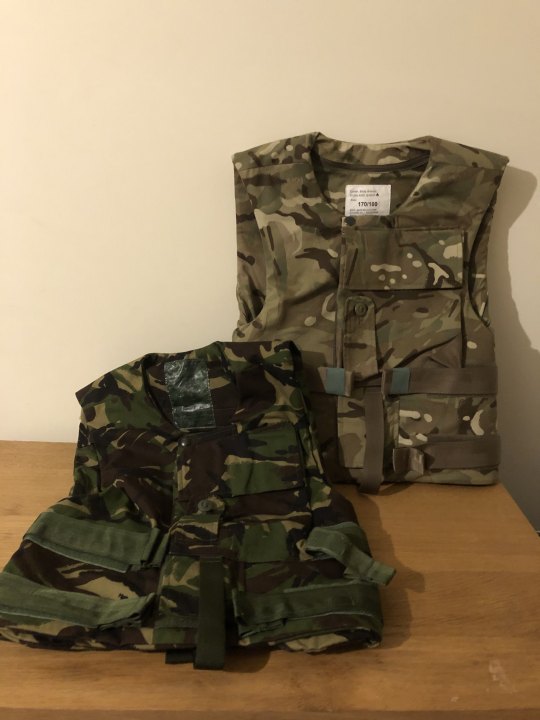
here you can see the two ECBA covers in my collection, the left being a 1999 production DPM cover, and the right being a 2013 production MTP cover. though there were also desert DPM and UN patterened ECBA covers. both with button flaps for rank slides affixed to the front pocket, something the CBA was missing.
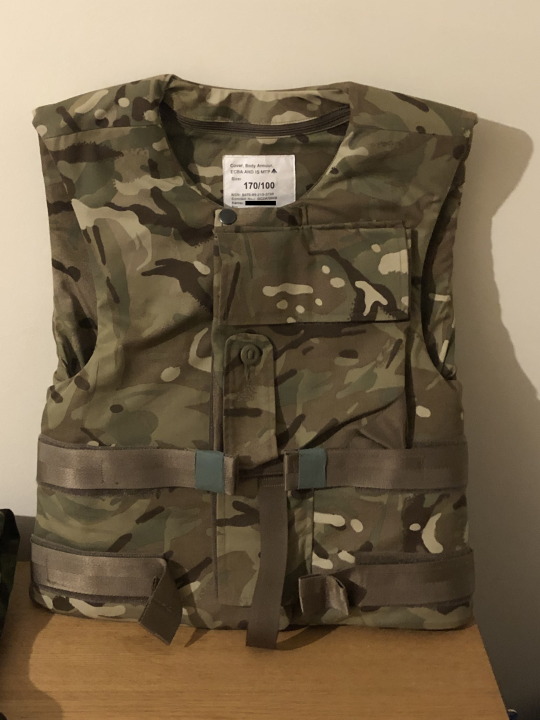
it might surprise some that the ECBA was still in production in 2013, especially considering the osprey armour system had been issued as replacement since 2006, but ECBA was still issued to rear echelon forces and those not expecting to see high-intensity conflict, such as those deployed during the manchester riots in 2011.

(apologies for the low definition photo)
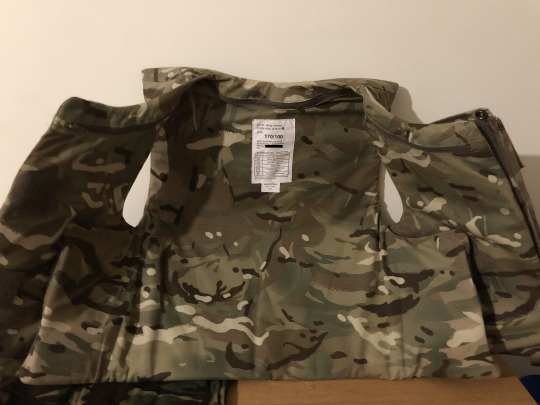
both the CBA and ECBA have the same vest opening and closure system, with two layers of velcro and a metal press stud at the top to ensure the armour is worn flat around the body. here you can also see that the armour is separated into three distinct pieces, all connected at the top of the back: the left wing, the right wing and the back pannel. the zip running along the top is used to insert/remove the soft armour filling.
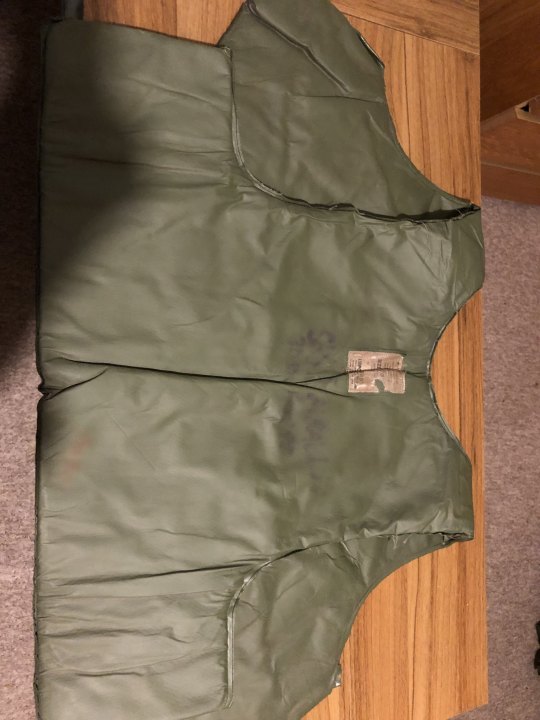
within these three (3) pieces fold a single olive-green backer, this is a thick multi-layered kevlar insert fitted into a plastic envelope. these came in a variety of sizes, relating to the size of cover worn, and were interchangeable between the CBA, ECBA and the later AFV Crewmember's vest, that I have little to no info on. this kevlar backer is rated to stop 9x19 FMJ and most if not all fragmentation from explosives, but is not rated to stop higher calibre or energy balistic threats.
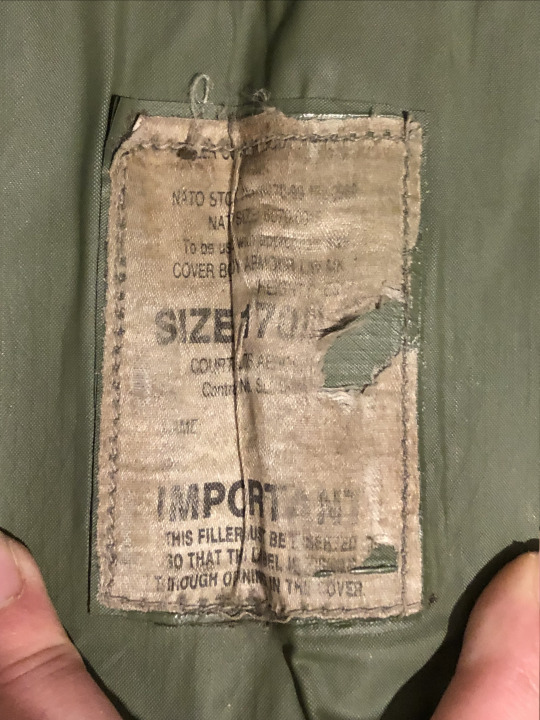
this filler is likely from the mid 1980s/early 1990s production CBA's, as the labelling has significantly degraded from frequent wear, and looks to be the early L/W Mk.1 filler. it was important to ensure that the label faced the inside of the cover, as the kevlar layered composite would not interact properly with projectiles if turned the wrong way around.

the other side is marked with a warning, and a scrawled on name, likely someone who was issued this armour in the past.
while i don't actually own any of the hard ceramic insert plates, they can rarely be found online and i have some photos of their usage to show.

these plates were repurposed by the MOD as the cumberbund plates for the osprey system, so they don't often get surplused and rarely end up on the "grey" market. this plate is a later model, and can be distinguished by the rounded off corners for ease of insertion and removal. the plate is composed of a sintered alumina body with a thin but tight cloth and resin covering to ensure that side blowout does not occur, and reduce the effectiveness of the plate.
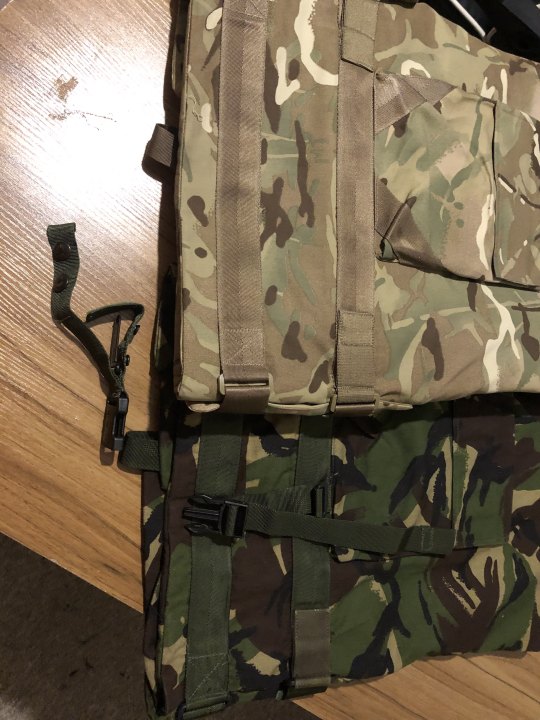
a final note of difference relates to the difference between pre and post herrick ECBA covers; pre-herrick covers had buckle attachment points for affixing to the issued PLCE webbing kit, though it was unlikely it was frequently used, as it is rather clunky and uncomfortable. it also reduced the speed at which armour could be taken off, as well as reducing the rotation of the torso relative to the hips, so this was then removed on post herrick MTP covers.
that's really all I have for today, but i hope you enjoyed the read, feel free to say if i got something wrong, or if i missed something you think is important!
thank you :)
2 notes
·
View notes
Text
If the main 6 of OMORI played tf2 this is who they'd main and how they'd play them. (Acoording to me)
Sunny - Sniper.
Actually very good at sniper.
Uses the Sydney Sleeper + SMG + Gold Pan (Got the Gold Pan from his 143rd Manhattan Tour.)
So good with the SMG it makes other people think it's brain dead easy to use. (It isn't.)
Wears 1 in-game cosmetic. (Literally just default sniper with an mvm canteen)
Aubrey - Scout.
Decent Scout player, would be very good if not for her sometimes shitty internet.
Uses almost every scout weapon interchangeably.
Very aggressive player, often runs into danger head-first, somehow survives almost 65% percent of the time. (Unless the danger is a sentry.)
Everything is painted Pink.
Kel - Soldier
He's okay at the game.
Mostly runs some variant on the trolldier loadout.
Not the best at rocket jumping, but he's decent.
Definitely has a killstreak Market Gardener.
Orange cosmetics.
Hero - Pyro.
The best Py-Bro you will ever encounter. He'll put you out if you're on fire, light huntsman arrows, destroy sappers and spies, and airblast projectiles away.
He tends to sit in the middle of the fight, to he can do all of the support things at one time.
Uses the stock Flamethrower, Alternates between the Flare Gun and the Detonator, and alternates between the Homewrecker and the Neon Annihilator.
Tries to make his Pyro look as non-threatening as possible, but he could totally wreck your team with a pocket kritz.
Basil - Engineer.
Literally has Uncle Dane level skill. I'm talking perfect building placements, AND god tier aim.
Will run any loadout no matter how silly, but usually just ends up running stock with the jag.
Even has a flower theme to his engi loadout.
Mari - Medic.
Her skill with the Crusader's Crossbow is comparable to her brother's skill with his sniper rifle.
Hesitates on using Übercharges, but usually finds a way to make them work.
Runs the Crusader's, All mediguns interchangeably, and the Übersaw.
She'll Über anyone. Even Spies.
9 notes
·
View notes
Note
I just want to say thank you for pointing out that open ended canon doesn't make up for major skipping of on screen character development, especially when women and poc are involved. Same with other groups who don't always have consistent treatment in film or TV or real life. I love headcanons and playing with concepts but I don't want to have to fill in huge gaping hole sized gaps all the damn time for the same characters who just so happen to fall into a specific demographic. At some point it's no longer a coincidence.
I don't want to be told well there wasn't time for Gamora to get a funeral or have her emotions around being in the future explored and it's okay because I'm sure it happened and we can just imagine everyone cared. How about no. How about if Yondu can get a funeral, a flashback in the holiday special and a quick spiritual glimpse in vol 3, they could do much better by Gamora. If they had used her coming to the future as a way to have a new life with the guardians and new bonds I'd be more okay with it. James Gunn didn't do that though. He had her get a new family we never see developed and then have her old family a stupid mix of "I'm losing my mind" (Peter) and "lol whose Gamora we don't know her"(everyone else). With Nebula and her having a decent groove and being sisters but we don't know how that's been going. The whole thing is painful to me.
so true anon!! like the way women and poc are dismissed and treated irl has always informed their less than great treatment in film and tv more often than not, and when we see it happen, we should be able to call it out and dissect it and feel our feelings about it together. at the end of the day, gunn still writes from his white male pov (which i think everyone can agree has been blatantly obvious since vol 1), and it may result in some female, bipoc, and especially woc characters getting left behind in the end, intentionally or not.
i'm RLY glad you brought up yondu bc i hadn't even thought of those points before but YOU ARE SO RIGHT. yondu has gotten these incredible, impactful moments after his death that have been cool and all, but it's weird that someone who ultimately still treated peter so badly (despite loving him) and didn't have much of a relationship with the rest of the gotg besides rocket has been given a better onscreen legacy than someone who loved peter and the entire team so fully and unconditionally all along. even to her last breath, gamora was doing whatever she could, even if it meant killing herself, to try to protect them all, and the whole universe too, and then that's just...the last we see of her? ever? dead, at the bottom of the fridging cliff?
and yeah you pretty much summed up every character's attitude toward her in vol 3 lmaooo. like honestly if i were peter maybe i'd want to leave everyone at the end of vol 3 too, after being the only one made out to be grieving original gamora while everyone else is just chilling. like i think i would've been driven to a breaking point with that dynamic, Actually
and again, mcu CANON has been giving us all this stuff abt variant characters for years now, essentially treating them as all separate characters rather than the same, interchangeable individual just with different memories, so like. what am i supposed to do with all these "no it's still gamora she just doesn't remember us so it's fine" comments in the context of the mcu multiverse rules lol
7 notes
·
View notes
Text
The E-11 Blaster - Tech x F!OC (Part 1)
I haven’t written anything in a decade, so please forgive me if this is awful.
Word Count: 1,267
Warnings: None
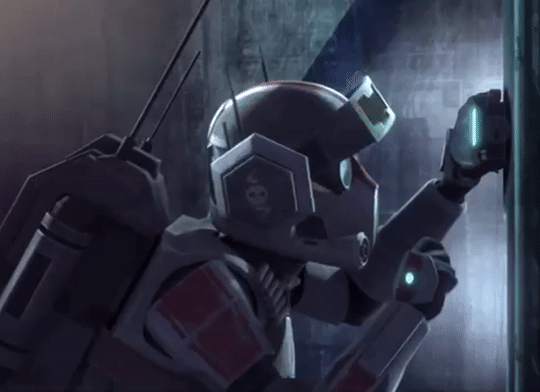
Tech was perched, body flat, on the dry Earth. He was hidden, high above the target, scouting for potential complications to the plan forming in his mind. Kelsa, the woman paying the Bad Batch for an extraction, had dropped down beside him. Her body extremely close to his. She could feel his cold armour pressed against her arm. “There are ten civilians, thirteen assailants, all clone troopers, between us and the main entryway. That means there are thirteen standard -”
“Standard issue E-11 blaster rifles between us and the front door. Yes, I know. I can see that.” Kelsa looked at Tech as if to say ‘do I look like an idiot to you?’ Kelsa had asked Clone Force 99 to help her, against her better judgement. She was out of options and they were out of credits. She knew that the crew were often sloppy, loud, no plan of theirs seemed to go quite according to plan and recently, they’d been travelling with a Kaminoan child. None of this seemed to suggest that this would be an easy or straightforward mission.
But... it was her best friend and despite all their shortcomings, they had survived a war, bounty hunters and even podracing in recent weeks. Their success rate was somehow 100%. However unlikely this seemed to Kelsa.
“How did you -” before Tech could even finish his sentence, Kelsa interrupted with a roll of her eyes. Best to save him from rolling off an unnecessary question.
“Know? It’s the Empire. They are clone troopers. Of course they have standard issue E-11 Blaster Rifles. Only snipers or commanders would be able to deviate from that.” Tech adjusted his goggles and found his focus drifting from the sight below.
He looked at Kelsa before asking, “how would you know that?” Kelsa cleared her throat.
“Beatiza and I did some work for Commander Cody and General Kenobi when the war was raging. We picked up some intel along the way and have been able to keep track of military supplies and equipment ever since. I read up on whatever intel we have, whenever I can.” Tech admired her for a moment, not her appearance but that despite his slight irritation with her attitude, she was like him. Clearly not as smart but she understands the importance of information.
“There are variants to the ‘standard clone trooper’ as you would put it. Clone Force 99, for example, is a key example of this.”
“You were designed to be heightened defective clones. Again, of course you would differ.” She had rolled onto her side and placed her head on her hand as she observed him. “But I am aware that you use DC-17 hand blasters, as does Hunter, along with his knife. Echo is new to your crew but since joining he also utilises the DC-17. Wrecker uses a DC-17m Interchangeable Weapons System... but likes a hands on approach to violence.” She rambled off her extensive knowledge at him. Hopefully he will stop treating me like a damsel in distress now, Kelsa thought.
This conversation had deviated a long way from their mission directive. They had clearly forgotten or, at least put aside, what they had been sent to do. Tech was indignant about the notion that his team could be so obviously analysed.
“How could you even possibly know all of that?” He queried, not meaning to sound so agitated.
“Commander Cody partly. He had a story to tell about you boys.” She chuckled, readjusting her head on her hand, “but, I forgot to mention this to you boys, I am a weapons specialist. Beatiza is a sort-of bodyguard and weapons tester, in case you wanted to know.” Tech searched her eyes for any evidence of a lie, there was none. He did also notice the large hazel eyes staring back at him, confused. “I do have a question, though. If you’ll allow it.”
They were so very, very far off topic now, Kelsa thought. So she didn’t seem the harm in asking the question that had been bothering her since she had first encountered 99. He nodded gently at her.
“Where is Crosshair? I was looking forward to meeting such a skilled sniper.” Would’ve been useful in this mission, she thought.
“He was,” Tech pushed backwards suddenly, his hands pressing his body backwards allowing him to lean on the boulder to his left. “He was left on Kamino when we deserted. His, uh, ideology seemed to differ to ours by that point. Though that could be the inhibitor chip, it is difficult to say for certain.”
Kelsa’s casual position no longer felt acceptable. So she sat upright, crossing her legs and looking at him sadly. His expression was crestfallen, gaze facing the floor. She shouldn’t have asked, she realised that now.
With a cough, Tech informed that “none of this conversation is relevant to the task at hand.” He forced his gaze back up to her face, “we should remain focused.”
She nodded and slid back down towards the view of the bridge and entryway. Immediately, she felt a presence at her side, Tech had rejoined her and had lowered his visor to inspect the environment. “Right so...” she lifted her binoculars to her eyes, “thirteen guards, several civilians. No heavy artillery. There will be something powering that door though. That will be a challenge.”
“Not for me.” He said with such confidence that Kelsa couldn’t tell if it came from battle experience or simply from his enhanced genetics. “As long as Hunter and the others can get me close enough and provide me with sufficient cover, as they always do, I will be able to lower that door.”
“Then we rescue Beatiza.”
“Precisely.”
“Simple.” She laughed, shaking her head. Her curls moving across her back and around her face.
“Well, it has the potential to be simple. We are operating under the impression that they are not keeping your friend somewhere deeper inside the fortress. We should consider the possibility that she is being kept somewhere further out of reach. Keeping her in the main hall seems unlikely.”
“Despite the strange presence of the Empire and their clones, the people on this planet are fairly primitive. Surely there isn’t a cage they can keep her locked in that the wonderous Bad Batch can’t rescue her from?” Her mouth twitched into what could only be interpreted as a smirk. Was she mocking us? Tech pushed that thought from his mind. It was illogical, she had only been polite and forthcoming towards his team so far. He couldn’t decipher her true meaning and again, he found himself irritated.
“You would be correct in your summation.” He announced. “We will free your comrade, do not worry.” With that final remark, Tech slid further down the rough terrain and sat himself back up against the boulder. He removed his helmet and turned his attention fully on Kelsa, once again. She remained flat staring down at the task at hand.
Her auburn hair bristled in the slight breeze but it still cascaded around her shoulders. Her legs, slightly parted, were covered by tight cargo pants. She needed the pockets for her tools as a weapons specialist, he thought. She wore a baggy shirt over her torso and had an E-10 rifle strapped around her back, though it appeared to be modified.
If Tech were any other man, an ordinary man even, he would have described the woman before him as beautiful. Yet, there was a mission to complete. So with a nervous cough, in an attempt to get her attention, Tech announced “we should return to the others.”
12 notes
·
View notes
Text
How to Identify the Right Subaru Sambar Parts for Your Model
The Subaru Sambar is a renowned compact kei truck and van from Subaru, popular for its impressive fuel economy, reliability, and versatility. If you're a proud owner of a Subaru Sambar, you know that maintenance and proper care are essential to keep it running smoothly. One of the most important aspects of maintaining your Sambar is ensuring you have the right Subaru Sambar parts for your specific model. In this article, we’ll guide you through the process of identifying the correct parts for your vehicle, taking into account various model years, trim levels, and common issues.
Understanding the Subaru Sambar
Before diving into how to identify the right parts for your Subaru Sambar, it's important to understand the vehicle itself. Introduced in 1961, the Subaru Sambar has evolved through multiple generations, becoming one of the most popular microvans in Japan. Known for its small size and impressive payload capacity, the Sambar is commonly used for personal transport, delivery, and even as a commercial vehicle in various markets.
The Subaru Sambar is available in several configurations, including the standard van and truck variants. It has also been offered with both rear-wheel and four-wheel drive options. Over the years, the Sambar has been powered by a variety of small engines, ranging from 360cc to 660cc. While the body styles and engine configurations may differ, one thing remains constant: the need for genuine, high-quality parts to ensure that your Sambar remains in top condition.
1. Identify Your Subaru Sambar’s Year and Model
The first step in finding the right Subaru Sambar parts is to determine your vehicle’s year and model. Different model years often come with unique components and specifications. Subaru has released various versions of the Sambar over the years, and some parts are not interchangeable between models.
How to Determine Your Model Year and Variant:
Check the Vehicle Identification Number (VIN): The VIN of your Subaru Sambar is a unique code that contains important information about the vehicle, such as the manufacturing year, the engine type, and the body style. You can usually find the VIN on the dashboard near the windshield or inside the driver’s side door frame. This code is crucial for finding parts that are specific to your model.
Vehicle Registration or Manual: Your vehicle’s registration document or owner’s manual may also list the specific model year and variant of your Subaru Sambar. This can help you confirm which parts are appropriate for your vehicle.
Visual Differences Between Generations: If you can’t find your VIN or registration, you can often identify your Sambar model by visual cues. Early models (1960s to 1980s) feature a more boxy design, while newer models (1990s to the present) are generally more rounded and aerodynamically shaped. Additionally, early Sambars were powered by smaller 360cc engines, while later models were equipped with larger 660cc engines.
2. Determine the Specific Trim Level and Configuration
Once you’ve identified the year and model of your Subaru Sambar, it’s time to determine its specific trim level and configuration. Subaru has offered various trims and configurations over the years, and this affects the parts required for your vehicle. For example, if your Sambar is a four-wheel-drive version, certain suspension components will differ from a rear-wheel-drive model.
Key Configurations to Consider:
Engine Type and Size: The Subaru Sambar has been equipped with several engine variants over the years. These range from 360cc engines in the early models to the 660cc engines in more recent versions. The engine type can affect parts such as the ignition system, fuel system, and exhaust components.
Drive Type: Some Subaru Sambar models are rear-wheel drive (RWD), while others are four-wheel drive (4WD). The 4WD models feature a different drivetrain, suspension, and axles compared to their RWD counterparts. When replacing parts related to the drivetrain, such as the axle shafts, driveshafts, and suspension components, you must ensure compatibility with your vehicle’s drive type.
Body Style: The Subaru Sambar comes in two primary body styles: the truck and the van. The truck variant typically has a bed for hauling cargo, while the van variant has a full passenger cabin. Depending on your model’s body style, the parts you need may differ. For example, interior components like seats and carpeting will vary between the truck and van configurations.
3. Common Subaru Sambar Parts and Their Variants
Now that you have a better understanding of your vehicle’s specifics, it’s time to dive into some of the most common parts you may need to replace. When ordering Subaru Sambar parts, always make sure you are ordering parts that are compatible with your model year, trim level, and engine type. Below are some key components and their variations across different Sambar models.
Engine Parts:
Timing Belt and Chain: Over time, the timing belt or timing chain on your Subaru Sambar will wear out and need replacing. The timing mechanism may vary depending on your model’s engine size. Some models use a belt, while others use a chain. Always refer to your owner’s manual to confirm the type of engine you have before ordering these parts.
Spark Plugs and Ignition Components: Ignition systems in the Subaru Sambar have evolved with the model. Earlier models used conventional distributors and mechanical ignition systems, while later models feature more modern electronic systems. Ensure you’re selecting the right spark plugs and ignition coils for your specific engine configuration.
Fuel System Parts: Whether your Subaru Sambar uses a carburetor or fuel injection, fuel system components like fuel filters, fuel pumps, and fuel injectors can wear out over time. Be sure to verify whether your model uses carburetion or fuel injection to avoid purchasing incompatible parts.
Suspension and Drivetrain Parts:
Shocks and Struts: The suspension system on your Subaru Sambar is essential for a smooth and comfortable ride. Suspension components like shocks and struts can wear out over time, particularly on models with high mileage. Depending on whether you have a 2WD or 4WD Sambar, these parts may differ in design and size.
Axles and Differential Components: If you own a 4WD Subaru Sambar, it’s crucial to ensure that the axles, differential, and driveshafts are compatible with your vehicle’s drivetrain. Rear-wheel-drive Sambars will use different axle assemblies, and the parts should be chosen accordingly.
Brake System Parts:
Brake Pads and Rotors: The brake system on your Subaru Sambar is another critical area to keep in mind. Both rear-wheel and four-wheel drive models have different braking setups, so ensure you’re choosing the correct parts based on your model’s configuration.
Brake Master Cylinder and Lines: The brake master cylinder and brake lines also vary in different configurations. If your Sambar has ABS (anti-lock braking system), ensure that replacement parts are compatible with this feature.
Exterior and Body Parts:
Body Panels and Bumpers: Over time, body panels like doors, fenders, and bumpers may become damaged or worn. While many parts may look similar, minor differences exist between model years and trims. Be sure to match the exact specifications to avoid incompatibility issues.
Lights and Signals: If you're replacing lights, such as headlights, tail lights, or turn signals, it’s crucial to check the model year, trim, and whether your Sambar is equipped with additional features like fog lights or LED lighting. Different models may use different connectors or light housing designs.
Interior Parts:
Seats and Upholstery: Depending on whether your Subaru Sambar is a truck or a van, the interior seating configuration will vary. The truck variant may have a more basic interior, while the van version may feature more passenger-oriented components like adjustable seats, headrests, and armrests.
Dashboard Components: Dashboard components, including the instrument cluster, air conditioning controls, and stereo system, may be different in models with upgraded trim levels. Be sure to order replacement parts based on your specific interior setup.
4. Sourcing Subaru Sambar Parts
Once you've determined the specific parts you need, the next step is sourcing them. Here are some options for finding Subaru Sambar parts:
OEM Parts Dealers: Original Equipment Manufacturer (OEM) parts are often the best choice for replacing worn or damaged components. Many Subaru dealerships or authorized parts suppliers offer OEM parts for the Sambar. While OEM parts may be more expensive, they are designed specifically for your model and ensure optimal performance.
Aftermarket Parts Suppliers: Aftermarket parts are typically more affordable than OEM options, but the quality can vary. Ensure that you choose reputable suppliers who provide high-quality aftermarket parts that meet the same specifications as OEM parts.
JDM Importers: Subaru Sambar parts are sometimes difficult to find in markets outside of Japan. However, many JDM (Japanese Domestic Market) importers specialize in sourcing genuine parts for vehicles like the Sambar. These parts may come directly from Japan, ensuring that they’re authentic and compatible with your model.
5. Installation and Maintenance Tips
Once you’ve obtained the right Subaru Sambar parts, proper installation is key to ensuring long-lasting performance. If you're comfortable working on your vehicle, you can attempt the installation yourself with the right tools and guidance. However, for more complex repairs, it's always a good idea to consult a professional mechanic.
Maintenance Tips:
Regularly check your Sambar’s fluid levels (engine oil, coolant, brake fluid, etc.).
Replace the air filter, fuel filter, and spark plugs at the recommended intervals.
Inspect your suspension components and brake system for wear and tear.
Keep your vehicle clean and protect the undercarriage from rust, especially in areas that experience harsh winters or frequent rain.
Conclusion
Identifying the right Subaru Sambar parts for your model is essential to ensuring the longevity and performance of your vehicle. By carefully determining the model year, trim level, engine configuration, and sourcing genuine parts, you can maintain your Sambar with confidence. Whether you’re replacing simple components like filters or more complex parts like suspension or drivetrain components, always prioritize quality and compatibility to keep your Subaru Sambar running at its best.
0 notes
Text
Choosing the Right Eyeglasses or Contact Lenses

In today’s global environment, visual correction devices are not only functional vision correctors but also conveying personal characteristics and living patterns. If you are a beginner to vision correction or thinking of shifting from one technique to the other, the type of eyewear you use is essential for your vision as well as comfort. Here is a guide to aid you make the right choice for the right option to consider.
Education: The Kind of Vision You Require
When deciding what vision correction method to use, eyeglasses or contact lenses it is important to assess vision needs. Visit your eye doctor to find out the degree of your vision problem, including myopia, hyperopia, astigmatism or presbyopia. A specific prescription should now give a clear structure to your choice.
Benefits of Eyeglasses
They are classic accessories that remain pretty useful to this date. Here are some reasons why:
Low Maintenance: First, it is possible to avoid contact with your fingers and water to remove eyeglasses unlike in the case of contact lenses which have to be cleaned daily.
Durability: A good pair will be fine for years of service when properly maintained.
Style Statement: Today’s eyeglasses are available in many styles, colors, and materials so you can show who you really are.
Health Benefits: Masks do not come in direct contact with a face, thus minimizing the likelihood of skin infections and dryness of the eyes.
Advantages of Contact Lenses
With contact lenses one can have flexibility and the added convenience, especially for those who revel in an active life. Benefits include:
Natural Vision: In contacts, they touch the eye and this allows for a broader view with little or no obstacles.
Activity-Friendly: Sports and Physical activities will suit best in this locale.
Aesthetic Appeal: Contacts do not change your physical form at all and can infringe on color for a variance.
Factors to Consider
When choosing between eyeglasses and contact lenses, keep the following in mind:
Lifestyle: Holsten and Hilpert asked you to think about your daily endeavors. In case you are active, you’d benefit from wearing contacts as opposed to glasses. For office work, glasses may be useful when it comes to reduced eye strain that results from working on screens.
Comfort: While some people complain that glasses are uncomfortable when worn, others experience uncomfortable feelings while using contact lenses.
Cost: This is common knowledge but eyeglasses can be costly when procured but the continuous purchasing of contact lenses makes them costly in the long run.
Eye Health: Dry eye or other eye conditions you may have should be discussed with your optometrist before the use of the lenses.
Combining Both Options
A large number of people may consider it useful to possess both a pair of glasses and a contact lens. This way one can change depending on the occasion and activity; glasses when staying at home or at work and contact lenses while going out dancing or exercising.
Choosing the Right Fit
For Eyeglasses:
Make sure that they compliment your face shape.
Sequently use easy to carry materials which are also long lasting.
Such features as the lens anti-reflective or blue light blocking coating should also be discussed.
For Contact Lenses:
If you are a beginner then it would be wiser to begin using daily disposables.
Infections should be prevented hence people should observe cleanliness.
People who use contact lenses should ensure they visit an eye expert for eye checkups to ensure they fit well.
Conclusion
The decision of having to use either eyeglasses or contact lens depends on one’s preferences, daily activities, and vision requirements. Each of them has its various benefits, and quite often it turns out that in order to achieve the desired effect, it is best to use both variants interchangeably. For specific advice on which product is best for your eyes, and whether it is right for you in the long-term, always speak to your eye care specialist.
This way, you make an informed decision and do not only improve your vision but also add style and confidence.
#best eye surgery in ahmedabad#eye hospital ahmedabad#eye surgery#eye specialist in ahmedabad#best eye tips#eye tips#eye hospital#best eye hospital in ahmedabad#Eye specialist in Ahmedabad#eye contact#Eye Glasses#Eye lenses
0 notes
Text
Comprehensive Guide to Fasteners Standards
Introduction
Fasteners are an important part of various industries, including construction, aerospace, and so on. They ensure safety and sound structures and machinery. In order to ensure quality, reliability, and interchangeability, fasteners are manufactured to established standards. These standards include such dimensions, material properties, testing requirements, and performance criteria for fasteners.
In this blog, we shall examine fasteners standards in detail, their importance, different types, and how they are implemented across various industries.
What Are Fasteners Standards?
Fasteners standards refer to guidelines put in place by organizations that ensure fasteners meet specific requirements for performance, safety, and compatibility. Standards often act as a common tool that manufacturers, suppliers, and end-users use in choosing the most appropriate fastener for the job.
Importance of Fasteners Standards
Consistency: Standards provide size, material, and performance uniformity.
Interchangeability: Fasteners made to standards can be substituted without incompatibility.
Safety: Following established standards helps minimize the risk of structural failure.
Global Trade: Standards promote international trade by removing technical barriers.
Major Organizations That Set Fasteners Standards
The following are some of the global standardized organizations that set fasteners standards:
ISO (International Organization for Standardization):
ISO International Standards are globally accepted, but they range from simple fasteners like screws and bolts to complex ones like washers.
Example: ISO 898 mechanical properties of fasteners made of carbon steel and alloy steel.
ASTM (American Society for Testing and Materials)
ASTM International standards are widely used in the United States and around the world in terms of material property, testing, and performance.
Examples: ASTM A193; alloy steel and stainless steel bolts for high-temperature and pressure applications.
ASME (American Society of Mechanical Engineers):
ASME standards emphasize dimensional and performance requirements.
Example: ASME B18.2.1 for square and hex bolts.
DIN (Deutsches Institut für Normung):
DIN standards are the German-based standards that are widely recognized and used across Europe.
Example: DIN 933 for hexagonal bolts.
BSI (British Standards Institution):
UK-based standards generally aligned with ISO.
Example: BS 3692 for high-strength precision bolts.
JIS (Japanese Industrial Standards):
Standards for fasteners widely used in Asia.
Example: JIS B1180 for bolts.
Variants of Fasteners Standards
Fasteners standards are classified based on their use, materials and mechanical properties. Some of the major standards are listed as follows
Dimensional Standards:
Measure dimensions including thread pitch, diameter, and length.
Example: ISO 965 for metric screw threads.
Material Standards:
Include chemical composition and mechanical properties
Example: ASTM A276 for stainless steel bars applied to fasteners
Performance Standards:
In relation to load capacity, hardness, tensile strength, and so forth
Example: ISO 3506 for mechanical properties of stainless steel fasteners
Coating Standards:
Define corrosion resistance properties.
Example: ISO 10683 for zinc flake coatings.
Application-Specific Standards:
Standards for fasteners used in particular industries.
Example: SAE J429 for automotive-grade bolts.
How Fasteners Standards Impact Manufacturing and Supply
Manufacturers adhere to standards to ensure product quality and compliance. By following standards:
Manufacturers guarantee reliability and global compatibility.
Suppliers provide traceable and certified products.
End-users receive products that meet specific needs with ensured performance.
Why Choose a Fastener Manufacturer Compliant with Standards?
Working with a manufacturer like Ananka Group ensures:
Precision-engineered fasteners that meet international standards.
A wide variety of certified fasteners for all industries
Highly expert help in the selection of the right fasteners for your application.
Conclusion
Standards for fasteners are the foundation for reliable and safe engineering solutions. Understanding these standards can go a long way in making informed decisions, ensuring compatibility, safety, and durability in whatever project is undertaken. Always source fasteners from such a reputed manufacturer who adheres to recognized standards.
FAQs
Q1. Why are fastener standards important?
A: They ensure safety, consistency, and global compatibility, hence very important in engineering applications.
Q2. What are some of the most frequently used fastener standards?
A: ISO, ASTM, ASME, DIN, and JIS.
Q3. How would I know if the fastener is to the standard I am targeting?
A: Through signs or stamps from the manufacturer, thus indicating the fastener complies with the standard.
Q4. Can a fastener meet more than one standard?
A: Yes, some fasteners are designed to meet multiple standards, especially for global compatibility.
Q5. What are the consequences of using non-standard fasteners?
A: Using non-standard fasteners can lead to compatibility problems, safety risks, and even possible structural failures.
#Fasteners#FastenersManufacturer#AnankaFasteners#Standard#FastenersStandard#Grade#ananka#manufacturer#usa#supplier#mumbai#hex#bolt#uk
0 notes
Text
OPINION: Simple =/= Lazy

Whenever something is simple, it's often blanketly seen as lazy or low effort by detractors. Those who are family with my page know that I vehemently hate whenever those terms are used for movies or TV shows. I also think it's wrong to assume anything that's simple is automatically lazy. It's time we're reminded that these are vastly different terms and should not be used interchangeably, less we as a society continue to be misinformed.

We take for granted the many tools, programs, recipes, and instructions that are simple. The keyboard format in which most computers have is simple and easy to figure out. The 5 simple machines (screw, lever, pully, wheel&axel, and wedge) are basic by design. Making a simple bowl of cereal is something so easy even a child can do it. We as people have always made things simple, as far back as the caveman days. It wasn't out of laziness or lack of thought, but rather for the sake of necessity. You know before 911 was invented we had do dial a 7 digit number to call the cops or an ambulance? And this was back in the mid-20th century, where instead of the iPhone we take for granted now, we had the painfully tedious rotary phone. What's worse is if you didn't have the number memorized, you had to rely on the phone book. See how complicated all that is? Making the emergency phone number just 3 digits was so simple, yet so genius. It has saved countless lives and was a big help for police officers responding to crimes in a more timely manner. Simplicity out of necessity is what makes life less difficult than it already is.

While we like our everyday devices to be simple out of necessity, it seems to be a different matter when it comes to our entertainment. A movie or a show being simple is often seen as a negative and one that screenwriters should avoid if they wish to dazzle critics. I'm all for taking risks, taking chances, and getting messy (comment if you got that reference 😉), I don't think it's an inherent bad thing to want to tell a simple story. A story that has a clear beginning, middle, and end, where the characters start their journey at point A and end it at point be, beat the bad guy, and live happily ever after is simple, yes, but lazy? Absolutely not. What I just described to you was something that opens the door to a wide range of different possibilities, where the only limit is your imagination. This basic story structure has had variants that date back to when we told stories via shadow puppets. While the narrative is simple, that doesn't mean it leaves no room for creativity. Case in point, The Super Mario Bros. Movie. Now, I'm not some pretentious dolt who believes critics are wrong for not liking a movie when their opinions are just as valid as my on. The reception to the Super Mario Bros Movie, however, did seem to highlight a common problem with online criticism. This notion that the movie should've taken more risks and be more than just a 92 minute long advertisement for a video game franchise. I understand if a lot of critics were either bored or indifferent with the film as a whole. I can not, however, side with the notion that the movie would've been better if it was more complex. If they were to have made the movie more complex with longer scenes focusing on the characters having their own subplots or if it was about Mario and Luigi struggling financially and trying to earn enough money to pay their mother's medical bills (or something of the sort), it would take away from the other important aspects of storytelling. Aspects such as good pacing, creative world building, engaging characters interactions, clever and organic dialog, strong vocal performances, an impressive score, and dazzling visuals. Again, I understand if most critics were left cold by the film as a whole, but I don't agree with generally concensus that a complex, bold and risky script is inherently better than a straightforward and to the point script.
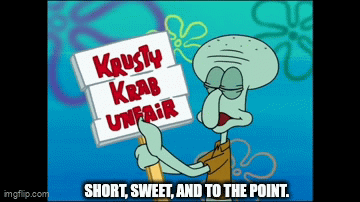
It's okay if one chooses the simpler option over the challenging one. Simplicity is how we, as people, are able to process information in a concise and fair manner. It's also how we get devices and recipes we take for granted every day. This also applies to the entertainment we consume. Movies and TV shows are supposed to be escapist entertainment that provides the audience with a good time. To conclude, I leave you with a quote from the late great Steve Jobs.

#reblog#share#like#follow#simple#opinion#the super mario bros movie#animation#comedy#critics#online#steve jobs#keep it simple
0 notes
Note
Salve! Is there a certain thought process you use when choosing how to form modern English phrases into Latin?
How do you choose which form of a verb/noun to use and decide between a plethora of synonyms?
Salve et tu!
Those are some good questions.
When I go to render modern English into Latin, the first thing that I do is think about the overall meaning of the English text and then try to think of some corresponding ideas according to the Latin idiom. I almost always consult Meissner’s Latin Phrasebook when I am at the “Latin idiom” stage of the process. This Meissner’s Latin Phrasebook is very helpful because it contains idiomatic Latin phrases (from the works of Cicero, Caesar, Livy, and others) which serve as translations of English phrases and terms which are relevant to many areas of life (e.g., parts of the body, the arts and sciences, and war). Unfortunately, this book is more than one hundred years old, so its usefulness is limited. If I cannot find the right phrase in this book, I usually then go to the Loeb Classical Library’s site and search for the English phrase, and then I see if I can find any place in Latin literature which corresponds to an English translation which contains the phrase. If this does not work, then I consult the latest edition of John Traupman’s New College Latin & English Dictionary, which contains many Neo-Latin terms. If I am still stuck, I look at Meissner’s Latin Phrasebook again to find a phrase which is similar in meaning to what I want to say in Latin and then change it a little to fit my needs. I might instead simply render the basic meaning of the English into Latin, using the “Preliminary Hints” section (comprising the sections “Avoid poetic, unusual, or late words” and “Use words in their normal Latin meaning” and “Translate thoughts, not words” and so on) of Bradley’s Arnold Latin Prose Composition as a guide. Sometimes there are instances where I just translate the English into Latin verbatim because the individual English words appear to be as important to the presentation as the ideas which they express.
Deciding on a particular word among several synonyms is often not too difficult. Latin has many synonyms, but almost none of them are truly interchangeable. (Lumen and lux, for example, might be interchanged in poetry, but that comes about due to poetic license, and there is indeed a difference: lux is light itself and lumen, which has the instrumental suffix -men, is a light source—a luc-men—like a lamp or the sun.) If I have trouble deciding on a particular word, I might consult Dumesnil’s Latin Synonyms or Döderlein’s Hand-book of Latin Synonyms. They are helpful, but again they are more than one hundred years old, so their translations do not always correspond to contemporary English (e.g., they might use the word passion to mean “suffering” rather than “strong feeling or emotion”). When it comes to more modern terms, I typically look at what Vicipaedia, the Latin Wikipedia, has to say about them. I also consult the latest addition of Traupman’s Conversational Latin for Oral Proficiency because this has a large Latin term list near the end. I also search through various other Neo-Latin sources like:
The Morgan-Owens Neo-Latin Lexicon;
Morgan’s Lexicon Latinum;
Lexicon Latinum Hodiernum;
Philosophia Latine Disserenda;
Latinitas Recens.
If I find variant translations of something, I decide on a translation according to these criteria:
whether the term is morphologically or syntactically valid according to the formation procedures which the Romans themselves employed (e.g., possestrix is good but the “possessrix” which appears in the Lexicon Latinum Hodiernum is garbage);
whether a variant of a term shows up in more than one of the sources;
whether the term comprises a single word or more than one word;
whether the term employs just Latin word elements or non-Latin elements like those from Greek or the modern Romance languages;
just plain euphony.
You might wonder how Neo-Latinists create neologisms. The first thing to realize is the fact that Latin is quite adverse to neologisms in general. The Roman writers and their later counterparts have been avoiding the creation of new words. They instead are more likely to write circumlocutions or paraphrases. (Writers are not always as steadfast about avoiding new words as Tacitus is at Annales 1.65 where he avoids calling spades spades, but sometimes they do come close.) Still, there might be times when neologisms are necessary. Fortunately, Latin is robust enough to have several options to coin new words. The options that we have are:
We can take an already-existing word and give it a new meaning (e.g., pellicula, originally “little hide,” but having the Neo-Latin meaning “movie” or “film”).
We can import a non-Latin word into the language and give it a Latin form (e.g., kimonum, from kimono, and the adjective iazzicus, from jazz). The Romans were doing this with Greek words for centuries, as seen in words like philosophia and polypus.
We can use the rules of Latin composition and derivation to create new Latin-form words (e.g., interrete, from inter and rete, for “internet,” and basipila, from basis and pila, for “baseball,” and even caeliscalpium, from caelum and scalpere, for “skyscraper”).
We can look to certain modern languages, like Greek and the Romance languages, to find modern phrases and then invent Latin calques of such terms (e.g., pomum terrestre for “potato,” which is a calque of the French phrase pomme de terre).
I believe what determines which of these to use in a particular situation has to do with the ease through which someone can deduce a neologism’s meaning according to its morphological or syntactical resemblance to modern terms.
Perhaps you noticed that although I create a lot of Latin compound words and derivatives, I rarely use any of them in my actual translations. That is intentional. I am following the typical Latinist procedure of creating and mentioning neologisms only when they are needed while at the same time working primarily with already existing and familiar Latin words. Most of the neologisms that I create exist because they are meant to demonstrate my skills in linguistics and wordsmithery. I want to see how these new words look and sound. And I create these words for fun. When I do my translations, however, I want to make it so that as many people as possible can understand what I want to say without having to rely too much on the idiosyncrasy of my neologisms. I think that anyone who knows how to read Latin should be able to work out the essential meanings of my translations.
Utinam hoc tibi prosit! I hope this is helpful!
Vale.
#latin#latin language#latin translation#lingua latina#tagamemnon#latin fandom#interretialia#Mema Interretialia#Latin grammar#Neo-Latin#Neo Latin#New Latin
34 notes
·
View notes